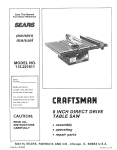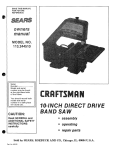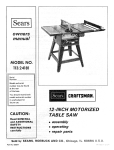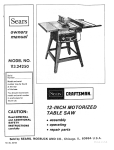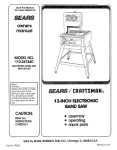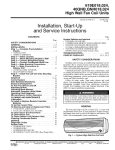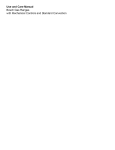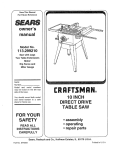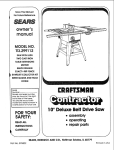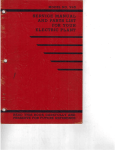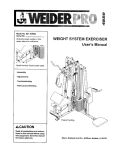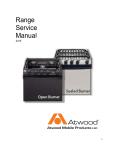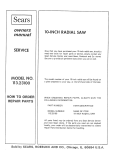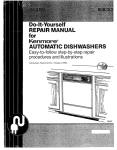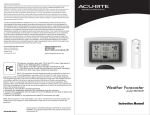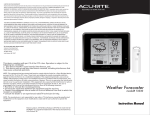Download Sears 113242502 Saw User Manual
Transcript
owners
manual
Serial
Number
Model and serial
number may be found
at the rear
of the base°
You should record both
model and seriat number
in a safe place for
future use,
12-INCH MO TORiZED
TABLE SAW
CAUTION:
Read GENERAL
and ADDITIONAL
SAFETY
,, assembly
INSTRUCTIONS
• operating
carefully
• repair parts
Sold
Part No, 62772
by SEARS,
ROEBUCK
AND
CO.,
Chicago,
IL. 60684
U.S.A.
Printed
in U S A
FULL ONE YEAR WARRANTY
ON CRAFTSMAN
TABLE
SAWS
If within one year from the date of purchase, this Craftsman Table Saw fails due to a defect in material or
workmanship, Sears will repair it, free of charge.
WARRANTY
SERVICE IS AVAILABLE
OR SERVICE CENTER THROUGHOUT
BY SIMPLY CONTACTING
THE UNITED STATES.,
THE NEAREST
SEARS STORE
This warranty gives you specific legal rights, and you may also have other rights which vary from state to
state°
SEARS,
,H,,,=.........
H
nnll
inH
==,=
general
ROEBUCK
AND
CO.., Seers Tower,
BSC 4t-3,
Chicago,
IL 60684
ii =HI
i
i
safely
insfrucfions
for power
i,J
tools
1. KNOW YOUR POWER TOOL
Read
and
affixed
as well
tool.
understand
owner's
manual
to the tool
Learn its application
as the specific potential
hazards
2. GROUND
This
the
and
labels
and Fimitadons
peculiar to this
ALL TOOLS
tool
is equipped
with
an approved
L_conductor
cord and a 3-prong grounding
type plug to fit the
proper grounding type receptacle
The green conductor
in the cord is the grounding
wire
Never connect the
green wire to a live terminal
3. KEEP GUARDS
in working
alignment,
IN PLACE
order,
and
in
4_ REMOVE ADJUSTING
AND WRENCHES
proper
adjustment
and
KEYS
Cluttered
areas
must not
and
be slippery
6. AVOID
CLEAN
benches
invite
accidents
Floor
due to wax or sawdust
DANGEROUS
AH visitors
area
8. MAKE
should
9. DON'T
force
designed
11. WEAR
a safe distance
from
work
KID-PROOF
master
switches,
or
by
removing
14. DON'T OVERREACH
Keep proper
footing
15, MAINTAIN
at att times.
TOOLS WITH CARE
before
blades,
TOOLS
servicing;
when
bits, cutters, etc
17, AVOID
changing
ACCIDENTAL
Make sure switch
in
the
accessories
such
as
STARTING
is in "OFF"
position
before
plugging
ACCESSORIES
owner's
manual
for
recommended
accessories
Follow
the instructions
the accessories
The use of improper
cause hazards
19. NEVER STAND
that accompany
accessories may
or attachment
injury could occur if the tool
too_ is accidentally
contacted
Do not
store
materials
Before
DAMAGED
further
is tipped
or if the
above or near the tool such that
to stand on the tool
to reach them
PARTS
use of the tool,
a guard
or other
part that
is damaged should be carefully
checked to ensure that it
will operate properly
and perform
its intended function
to do a job it was not
Check
for
parts,
breakage
PROPER APPAREL
conditions
Do not wear loose clothing,
gloves, neckties or jewelry
(rings,
wrist watches)
to get caught in moving
parts,
Nonslip
footwear
is recommended
Wear protective
hair covering
to contain
long hair
Roll long sleeves
above the elbow
GOGGLES
ON TOOL
Serious
cutting
for
12. USE SAFETY
and balance
Keep
tools sharp
and clean for
best and safest
performance
Foftow
instructions
for lubricating
and
changing accessories
2& CHECK
and safer at the rate for which
TOOL
toot
of
Use clamps or a vise to hold work when practical
It's
safer than using your hand, frees both hands to operate
too!
it is necessary
It will do the job better
it was designed
Don't
periods
13. SECURE WORK
Consult
FORCE TOOL
10, USE RIGHT
extended
AWAY
be kept
WORKSHOP
with
padlocks,
starter keys
during
18, USE RECOMMENDED
ENVIRONMENT
Don't
use power
tools in damp or wet locations
or
expose
them to rain
Keep work area well lighted
Provide adequate surrounding
work space
7. KEEP CHILDREN
(plugs or muffs)
16. DISCONNECT
Form habit of checking
to see that keys and adjusting
wrenches are removed
from Iool before turning
it on
5 KEEP WORK AREA
protectors
operation.
(Head Protection)
Wear Safety goggles (must comply
with ANS Z87,1) at
aH times,,
Everyday
eyeglasses
only
have impact
resistant
lenses, they are NOT safety glasses
Atso, use
face or dust mask if cutting operation
is dusty, and ear
alignment
that
other part that
or replaced.
21. DIRECTION
Feed work
of rotation
of moving
of
parts,
may
affect
is damaged
parts, binding
mounting,
its
operation
shoufd
any
A
be property
other
guard
or
repaired
OF FEED
into a blade or cutter against
of the blade or cutter only
22, NEVER LEAVE
UNATTENDED
Turn power off
complete
stop.
of moving
and
TOOL
Don't
the direction
RUNNING
leave
tool
until
it comes
to a
ADDDTaONAL
WARNING:
FOR
OPERATE
YOUR
ASSEMBLED
AND
INSTRUCTIONS
AND UNDERSTOOD
SAFETY RNSTRUCTSONS
YOUR
OWN
SAFETY,
DO
NOT
SAW
UNTIL
IT IS COMPLETELY
INSTALLED
ACCORDING
TO THE
AND
UNTIL
YOU
HAVE
READ
THE FOLLOWING,
1,
GENERAL
SAFETY
INSTRUCTIONS
FOR POWER
TOOLS .... SEE PAGE 2
2,_ GETTING
TO KNOW YOUR SAW .... SEE PAGE 15
3o BASIC SAW OPERATION
, ,. SEE PAGE 17
4, ADJUSTMENTS
..... SEE PAGE 23
5o MAINTENANCE
, _ o SEE PAGE 26
6_
STABILITY
if there
is any tendency
7o
the outer end of the extension
as appropriate.,
from
al! "THRU-SAWING"
thru the work) AND
by
D
Use extra
caution
when
the guard assembly
is
removed
for
resawing,
dadoing,
rabbeting,
or
molding
replace
the guard
as soon
as that
operation
is completed
E
For rip or rip*type
cuts, the following
end of a
workpiece
to which
a push stick or push board is
applied must be square (perpendicular
to the fence)
in order that feed pressure applied to the workpiece
by the push stick
or block
does not cause the
workpiece
to come
away
from
the fence,
and
possibly
cause a kickback
During rip and rip type cuts, the workplece
must be
for the saw to tip over or move
as cutting
boards, the
if you attach any kind of table extensions
over 24"
wide to either end of the saw, make sure you either
bolt the saw to the bench or floor as appropriate,
or
in
place
for
(sawing entirely
removing
all loose pieces from the table with a long
stick of wood IMMEDIATELY
after they are cut
off,
OF SAW
during
certain
cutting
operations
such
extremely
large heavy panels or long heavy
saw should be bolted down
support
or floor,
spreader
operations
FOR TABLE SAWS
F.
held down on the table and against the fence with a
push
stick,
push
block,
or featherboards
A
featherboard
is made of solid lumber per sketch..
the bench
LOCATION
The saw should be positioned
nor a casual observer is forced
saw blade
so neither
the operator
to stand in Iine with the
8o KICKBACKS
A "KICKBACK"
occurs during
a rip-type
operation
when a part or aU of the workpiece
is thrown
back
violently toward the operator
Keep your face and body to one side of the sawblade,
out of line with a possible "Kickback
"
Kickbacks
and possible
injury
from
them - can
usually be avoided by:
A Maintaining
the rip fence parallel to the sawblade
B
Keeping the sawbiade sharp, Repfacing antikickback
pawls when points become dull
C
D
E
Check their action before ripping.
NOT ripping work that is twisted or warped or does
not have a straight edge to guide along the rip fence
NOT releasing work untii you have pushed it all the
way past the sawblade
H
NEVER
turn
the saw "'ON"
before
clearing
table of all tools,
wood scraps, etc,
except
workpiece
and related
feed or support
devices
the operation
planned
NEVER
place your face or body in line with
the
the
for
the
cutting tool..
I,
NEVER
place your fingers or hands in the path of
the sawblade or other cutting tooI.
J
NEVER
reach in back of the cutting
tool
with
either hand to hold down or support the workpiece,
remove wood scraps, or for any other reason Avoid
awkward
operations
and hand positions
where
a
sudden
slip could cause fingers
or hand to move
into a sawblade or other cutting tool
K_ DO NOT perform
layout,
assembly, or setup work
on the table while the cutting tool is rotating.
L. DO NOT perform
any operation
"FREEHAND"
always
use either
the rip or the miter gauge to
F.
Using a "PUSH
STICK"
(See Page T6) for ripping
widths of 2 to 6 in, and an auxiliary
fence and push
block for ripping
widths
narrower
than 2 in (See
"Basic Saw Operation
Using The Rip Fence" section }
position and guide the work
M_ NEVER
use the rip fence when crosscutting
or the
miter gauge when ripping.DO
NOT use the rip fence
as a length stop
NEVER
hold onto or touch the "free end" of the
workplece
or a "free piece" that _s cut off, while
G
NOT confining
crosscutting.
N
H
9,
Keeping sawblade guard, spreader, and antikickback
pawts in place and operating
properly.
The spreader
must be in alignment
with
the sawblade and the
pawls must stop a kickback
once it has started.
G
When ripping
the workpiece
fence
the
cut-off
piece
when
ripping
or
apply the feed force to the section of
between
the saw bfade and the rip
PROTECTION:
EYES, HANDS,
FACE, EARS, BODY
A If any part of your saw is malfunctioning,
has been
damaged or broken
such as the motor switch, or
other
operating
control,
a safety device
or the
power
cord
cease operating
immediately
until
the particular
part is properly
repaired or replaced
B.
C.
Wear safety
and a face
goggles that comply
shield
if operation
p[ugs
or
operation
muffs
during
periods
can
usually
be avoided
by keeping
the
guard
and
cord
may be cut on your saw However,
since these are
usualty
quite
hard and slippery,
the antikickback
pawls may not stop a kickback
Therefore,
be especially
attentive
to following
proper
set-up and cutting
procedures
for ripping.
Do not stand, or permit anyone e_se to stand, in Iine
with a potential
kickback.
of
Small
loose pieces of wood or other objects
that
contact
the rear of the revolving
blade can be
thrown back at the operator at excessive speed. This
is rotating.
the power
when
removing
the
table
insert,
changing
the
cutting tool, removing or replacing
the blade guard,
or making adjustments.
O.. Provide adequate
support
to the rear and sides of
the saw table for wider or long workpieces.
P
PIastic and composition
(like hardboard)
materials
with ANSI Z87 1,
is dusty. Wear ear
extended
Dower is "ON"
and!or the sawblade
Shut "OFF"
the saw and disconnect
Q
If you stall or jam the sawblade in the workpieceo
turn saw "OFF",
remove the workpiece
from the
sawblade,
and check
to see if the sawblade
is
paraIlel
to the miter
gauge grooves
and if the
spreader
is in properalignment
withthesawblade,,
If rippingatthetime,checktoseeif theripfence
is parallel with the sawbladeReadjustas
indicated.
R.
DO
NOT
remove
small
pieces
of cut-off
material
that
may become
trapped
inside the blade guard
while the saw is running
This could endanger your
hands or cause a kickback.
Turn saw "OFF"
and
wait until
Use extra
S
grain
table
or is twisted
and/or pinch
10. KNOW
A.
blade stops
care when ripping
YOUR
wood
that
or bowed -- it may
the sawblade
CUTTING
has a twisted
rock
on the
TOOLS
Dull, gummy, or improperly
sharpened or set cutting
tools can cause material to stick, jam, stall the saw,
or kickback
at the operator
Minimize
potential
injury
by proper
cutting
roof
and machine maintenance,
NEVER
ATTEMPT
TO
FREE
A STALLED
SAWBLADE
SAW OFF,
B
WITHOUT
FIRST
TURNING
buffing
16. Never feed material
into the cutting
of the saw. An accident
and serious
17 Always
maintain
"let go" of the
come to a stop.
tool from the rear
injury could result.
control
of the workpiece
-- DO NOT
workpiece
until the cutting
tool has
18. IF YOUR SAW MAKES AN UNFAMILIAR
NOISE OR
IF
IT
VIBRATES
EXCESSIVELY
CEASE
OPERATING
IMMEDIATELY
UNTIL
THE SOURCE
HAS
BEEN
LOCATED
AND
THE
PROBLEM
CORRECTED.
19. If any part of this table
bend or fail in any way,
fail to perform properly,
cord from power supply
and/or failed parts before
20. THINK
saw is missing or should break,
or any electrical
component
shut off power switch, remove
and replace damaged, missing
resuming operation,
SAFETY,
Safety [sa combination
of operator
common
sense and
alertness at all times when the saw is being used.
THE
Never use grinding
wheels, abrasive cut-off
wheels,
friction
wheels (metal slitting blades) wire wheels or
11. USE
15. Adjust
tabie inserts flush with
the table top NEVER
Operate the saw unless the proper insert is installed
21oNOTE
THAT
AND
APPEAR
FOLLOW
ON THE
SAFETY
INSTRUCTIONS
FRONT
OF YOUR SAW,
wheels
ONLY
ACCESSORIES
DESIGNED
FOR
BEFD_
THIS
10p ER AT _
g _AA C Ht _ _. _
WE_,n SAFETY GDG_LE_ J'En Ar_
Tm!_!;
,_11
AT _,_.L
SAW_
12
Crosscutting
operations are more conveniently
worked
and with
greater safety if an auxiliary
wood facing is
attached
to the miter gauge using the holes provided
However, the facing must not interfere with the proper
functioning
of the sawbtade
guard,
13 Make sure the top of the arbor or cutting tool rotates
toward
you
when
standing
in normal
operating
position.
Also make sure the cutting
tool, arbor collars
and arbor nut are installed properly
Keep the cutting
tool
as low
as possible
for
the operation
being
performed
Keep all guards in place whenever
possible
14 Do not use any blade or other cutting tool marked for
,_ u,_ A ,,pUSt! =;T_cK'r W_tEN _Eo_*r_E D
_N
[_At_ER
22. WARNING:
DO
NOT
ALLOW
FAMILIARITY
(GAINED
FROM FREQUENT
USE OF YOUR SAW)
TO
BECOME
COMMONPLACE,
- ALWAYS
REMEMBER
THAT
A CARELESS
FRACTION
OF A
SECOND
IS SUFFICIENT
TO INFLICT
SEVERE
INJURY.
WEAR
The operation
of any power tool
can result in foreign
objects
being
YOUR
thrown
into
the eyes, which
can
result in severe eye damage° Always
wear safety goggles complying
with
ANSI
Z87.1
(shown
on Package)
an operating
speed less than 3450 RPM Never use a
cutting
tool
larger in diameter
than the diameter
for
which
the saw was designed
For greatest safety and
efficiency
when ripping,
use the maximum
diameter
blade for which
the saw is designed
since under these
conditions
the spreader
MOTOR
is nearest
AND
is a capacitor
specifications:
Phase
240
60
7
...................................
..............................
Single
.................................
RPM
.........................................
Rotation
(viewed
sawblade
end)
MOTOR
3450
from
..................
SAFETY
Counterclockwise
PROTECTOR
(RED BUTTON)
PROTECTION
the
The saw motor
is equipped
with
a manual-reset
thermal
overload
protector,
designed to open the power line circuit
when the motor temperature
exceeds a safe value.
1.
if
motor
[s overloaded
and
overload
protector
red button
will
not
snap into
place immediately,
is still too
hot
and must
be allowed
to
cool
longer.
3,,
As soon as the red button
will
snap into
running
position,
the saw may be started and operated normally
by moving the saw switch lever to the "ON"
position.
4_
Frequent
opening of fuses or circuit breakers may result
if motor
is overloaded,
or if the motor circuit
is fused
with a fuse other than those recommended.
Do not use
is
protector
is near the sawblade, the switch must not be
turned
"ON"
until after you have reset the protector
If the
motor
for a while
actuated
(stopping
motor)
BE POSITIVE
you push
switch "'OFF"
immediately
and allow the motor to cool
before
attempting
to reset the protector.
Since the
2
REQUIRE ENT$
start,
............................
Amperes
Hertz
ELECTRICAL
SPECIFICATIONS
The AC
motor
used
in this saw
non-reversible
type, with the following
Voltage
the blade
$PEC FICATIONS
MOTOR
before
commencing
power
tool
operation,
Safety
Goggles
are
available
at Sears retail or catalog
stores
a fuse of greater
company_
capacity
without
consulting
the power
5 Althoughthemotorisdesigned
for operation
on the
voltageandfrequency
specified
on motornameplate,
normalloadswill be handledsafelyon voltages
not
morethan10%above
or belowthenameplate
voltage.
Heavyloads,however,
requirethatvoltageat motor
terminalsbe not lessthanthe voltagespecified
on
nameplate
6 Mostmotor troublesmay be tracedto looseor
incorrect connections,
overloading,
reducedinput
voltage(whichresults
whensmallsizewiresareusedin
the supplycircuit)or whenthe supplycircuit is
extremely
long.Alwayscheckconnections,
loadand
supply
circuit
when
the
motor
fails
to perform
satisfactorily
Check wire sizes and lengths with
the
table in the next paragraph°
Replace or repair damaged
or worn cord immediately.
CONNECTING
This
saw
operator
TO POWER
must
be
from
grounded
electrical
This
while
in use to
protect
the
or cut,
saw is wired
or damaged
in any way,
have
for
operation
on 240
volts
only, Connect
to a 15 ampere branch circuit
protected
by a
15 ampere
time
delay or circuit
saver fuse or circuit
breaker,
WARNING:
Do not permit fingers to contact the terminals
of power or motor
plugs when installing
or removing
the
plug to or from a live power
source. Hold
the plug as
shown.
O,OUND_NG_LADE_s
LONGEST
OF 3 _LADES
GROUNDED,
ELECTRICIAN.
HAVE
IT
CHECKED
BY
A
WARNING:
tF
NOT
PROPERLY
GROUNDED
THIS
POWER TOOL CAN INCUR THE POTENTIAL
HAZARD
OF
ELECTRICAL
SHOCK,
PARTICULARLY
WHEN
USED
IN
DAMP
LOCATIONS,
IN
PROXIMITY
TO
PLUMBING,
OR OUT OF DOORS., IF AN ELECTRICAL
SHOCK
OCCURS
THERE
IS THE POTENTIAL
OF A
SECONDARY
HAZARD
SUCH
AS
YOUR
HANDS
CONTACTING
THE SAWBLADE.
This power
tool is equipped
with a 3_conductor
cord and
grounding
type plug which has a grounding
prong, approved
by Underwriters'
Laboratories
and the Canadian Standards
Association
The ground conductor
has a green lug and is
attached
to the tool housing at one end and to the ground
prong
The
OUTLET
shock
If power cord is worn
it replaced immediately
CAUTION:
SOURCE
PROPERLY
QUALIFIED
in the attachment
use of
any
power
To
kee_ this
over-heating
ar,
motor
determine
the minimum
Use
only
3
plug at the other
extension
wire
cord
will
end
cause
some
extension
cords
grounding
tools plug
type
tugs and 3pole
Extension
Cord
Length
which
receptacles
have
which
3
prong
accept
the
Wire Size AWG
Up to 100 ft ...........................
14
I00 fL to 200 ft ..........................
12
200 ft. to 400 ft
loss of
to a minimum
and to prevent
burn-out,
use the table below
to
wire size (A W G ) extension
cord
...................
8
NOTE:
For circuits of greater length, the wire size must be
increased proportionately
in order to deliver ample voltage
t40 ADAPTER IS
AVAILABLE FOR
THIS TYPE PLUG
GROUNDED
OUTLET _OX
IF
YOU
ARE
NOT
SURE
THAT
YOUR
OUTLET
IS
GROUND
G{_OUND
CONTENTS
2
.........................................
WARRANTY
ADDITIONAL
FOR TABLE
2
SAFETY INSTRUCTIONS
SAWS ................................. 3
AND
ELECTRICAL
4
.............................
MOTOR SPECIFICATIONS
REQUIREMENTS
..................................
UNPACKING
AND CHECKING
CONTENTS
...........
6
Tools Needed
.........................................
6
List of Loose Parts
6
.......................................
7
..................................
SAW
OPERATION
USING
16
THE
MITER
GAUGE
BASIC
SAW
OPERATION
USING
THE RIP FENCE
Ripping
..........................................
Bevel Ripping ................................
Ploughing
and Molding
Resawing
................................
Cutting
Panels
.................................
Rabbeting
.................................
Using Featherboards
.........................
GETTING TO KNOW YOUR SAW ..................
On-Off Switch
...............................
Elevation
Handwheel
.............................
Elevation
Lock ...................................
Tilt Crank
......................................
Removing
14
14
15
15
15
ADJUSTMENTS
1
....................................
15
I
.....................................
......................................
and Installing
Sawblade
5
15
..............
.................................
Miter Gauge
..................................
Heeling Adjustment
or Parallelism
Sawblade
to Miter Gauge Groove
Blade Tilt, or Squareness
of
Blade to Table ..................................
Elevation
Lock .................................
MAINTENANCE
LUBRICATION
.....................................
Rip Fence
Miter Gauge
Blade Guard
Table Insert
7
7
8
8
9
11
12
12
20
20
21
22
22
22
23
23
23
of
................
24
25
26
26
......................................
Legs
....................................
Table Insert
................................
Blade Squareness
to Table
................
and Assembling
Table Extensions
.........
Rip Fence Guide Bars ....................
Rip Fence ...........................
Rip Scale Pointer
.........................
Blade Guard
..........................
20
........................................
27
5
Attaching
Checking
Checking
Attaching
installing
Aligning
Adjusting
Installing
17
Work Helpers
.......................................17
Crosscutting
...................................
18
Repetitive
Cutting
................................
18
Miter Cutting
......................................
19
Bevel Crosscutting
.............................
19
Compound
Miter Cutting
....................
I9
.............................
ASSEMBLY
Exacti-Cut
BASIC
GENERAL
SAFETY INSTRUCTIONS
FOR POWER TOOLS
...................................
16
RECOMMENDED
TROUBLE
REPAIR
ACCESSORIES
SHOOTING
PARTS
...............
.........................
............................
27
28
30
UNPACKING
CHECKING
AND
NEEDED
CAUTION:
volatile
...........
Screwdriver
Screwdriver
a coat
Wipe
all
parts
WARNING:
CONNECT
ALL
HAVE
7/16
1/2 ino
3/4 in,,
Combination Square
COMBINATION
in.
SQUARE
MUST
STRAIGHT
3/Z
DRAW LIG_'{T
L_N_ ON
OF
9/16 im
BOARD
THICK
THI_ EDGE MUST
BE PERFECTLYSTRAIGHT
i
1
L.
/
i
BE
NO
GAP
OR
OVERLAP
HEREWHEN SOUAR{_ ISFLIPPED
OVER IN DOTTED POS_T_ON.
Model
complete
and Steel
113.242502
in one
Legs.
Motorized
carton
including
Table
Saw
is
Two
Table
Extensions
shipped
Separate
all parts from packing
materials
and check each
one with the illustration and the list of Loose Parts to make
certain
all items are accounted
for, before discarding
any
If any parts are missing, do not attempt
to assemble the
table saw, plug in the power cord or turn the switch
on
until
the missing
parts
are obtained
and are installed
Item
oil that is applied
Use any ordinary
to the table top
household
type
j
OWN
SOURCE
cloth.
SAFETY,
OUTLET
COMPLETE,
THE
NEVER
UNTIL
AND
SAFETY
OF
LOOSE
Qty,,
....................................
O
O
O
O
P
Q
R
R
R
R
R
S
S
S
T
U
V
W
S
T
T
c
X
YOU
AND
PARTS
Leg ....................................................
Stiffener
Table Extension
.........................
Spreader Support
..........................
Blade Guard and Spreader
.................
Fence Guide Bar (Rear)
.......................
Miter Gauge ................................................
Rip Fence
.................................
Guide Bar Rod
............................
Arbor
Nut Wrench ..................
..........
Arbor Wrench
...............................
Fence Guide Bar with IR_p Scale (Front)
.........
Owners Manual
...................................
Pkg. of Miscellaneous
Small Parts No, 62746
Consisting of the Following:
Setscrew Wrench, 3/32 in ..........................
Setscrew Wrench,
1/8 in ...........................
Setscrew Wrench, 5/32 in......................
Setscrew Wrench, 3/16 in .......................
Switch Key
......................................
Self-Threading
Nut
..........................
Hex Head Screw. 6116-18
x 1-314 in tong ....
HexHaadScrew.
B/T6-18x
1in
long
......
Hex Head Screw, 6/16-18
x 5/8 in. long .......
Hex Head Screw, t/4-20
x I12 in. long
....
Hex Head Screw, 1/4--20 x 5/8 in. long
....
Hex Nut, 5/16-18
(approx. dla._ of hole 5/16 in,) ..............
Hex Nut, 1/4--20
(approx,
die, of hole 1/4 in,)
...............
Hex Nut. 1/2--13
(approx.
die, of hole 1/2 in.) .................
Lockwasher,
B/16 in. External
Type
(approx dia. of hote 5/16 in .................
Lockwasher,
1/4 in Externa_ Type
(approx. dia.. of hofe I/4 in .) .................
Guide Bar Spacer
_ ............................
Thumbscrew,
5/16-18
x I in long
.........
Leveling Foot
.....................................
2 Pkgs, of Miscellaneous
Small Parts N0. 62745
for Table Extensions
consisting
of the Following;
Corner Support
Bracket
...............
Corner Stiffener Bracket
...................
Truss Hd. Screw, 1/4--20
x 1 im long
.......
Hex Hd. Screw, 5/16--18
x 1-1/4 in. long
.
Hex Nut; 1/4-20
(approx.
die, Of hole 1 t4 in.) ................
Hex Nut, 5/16--18
(approx, die. of hole 5/16 in ,) ..............
Lockwasher,
1/4 in, External
Type
(approx,
dia. of hole 1/4 in.)
...........
Loekwasher,
5/16 in. External
Type
(approx., dla. of hole 5/16 in.}
...........
FIat Washer. ! 1/32
R
S
M
YOUR
POWER
tabfe.
dry
Part Name
T
correctly,
to the
a clean,
INSTRUCTIONS,
LIST
pack ing material
Remove the protective
and edges of the tabie
grease and spot remover
FOR
PLUG
TO
wax
with
ASSEMBLY
STEPS
ARE
READ
AND
UNDERSTAND
A
B
C
D
E
F
G
H
J
K
L
M
N
BOARDALO,._GTH,,,DGE
_/.._ t"_i
'_. '
SHOULD
automobile
thoroughly
in_
BE TRUE°
EDGE
of
OPERATIONAL
Wrenches
318
Never use gasoline, naptha or similar highly
solvents,,
Appfy
Medium
Small
CONTENTS
.......................
SIZE
s
T
v
w
4
4
2
I
I
1
1
1
1
t
I
1
1
1
]
1
1
1
2
2
2
16
16
2
20
18
8
20
18
2
1
4
4
4
I6
8
16
8
16
8
8
ASSEMBLY
LEG
END
ATTACHING
1,
Turn
STIFFENER
LEGS
the saw upside
SIDE STIFFENER
down
NOTE:
DO NOT LAY
IT ON THE FLOOR
AS THIS
MAY SCRATCH
THE TABLE
SURFACE.
PLACE
IT
ON STRIPS OF WOOD OR PARTS OF THE PACKING
MATERIAL,,
2_
From
among
hardware:
the
loose
parts,
find
the
following
16 Hex, Head Screws, 5/16-18
x 5/8 in, long
16 Hex. Nuts, 5/16-18
(approx
dia of hole, 5/16 in.,)
16 Hex, Head Screws, 1/4 ira-20
x t/2 in. long
16Hex
Nuts, 1/4-20(approx,
dia.ofhoie,
1/4 in)
8 Hex.. Nuts, 1/2-13
(approx
dia of hole, 1/2 in.)
4 Leveling Feet
16 Lockwashers,
hole, I/4 in.)
1/4
in. External
I6 Lockwashers,
of hole, 5/16 in.)
5/16
in.
External
Type
(approx,
Type
NOTE:
The four stiffeners
are identical
ATTACH
THE
SIDE
STIFFENERS
OUTER
HOLES
....
ATTACH
END
USING INNER HOLES..
3.
4.
Insert
Install
dia
(approx
washers
5o
install leveling
6,.
Place saw in upright
and nuts
-18 ×
of
dia
BE SURE TO
USING
THE
STIFFENERS
screws
through
legs then
through
stiffeners
Iockwashers
and nuts. DO NOT TIGHTEN
After at1 screws,
all nuts_
5/!6
are installed,
END
STIFFENER
SIDE STIFFENER
tighten
feet..
position,.
INNER
HOLES
END
HOLES
BEFORE PROCEEDING
WITH THE ASSEMBLY,
THE
TABLE 1NSERT, BLADE SQUARENESS, AND BLADE
PARALLELISM
MUST BE CHECKED AT THIS TIME,
CHECKING
TABLE
INSERT
Insert should be flush with table top, Check as shown
Loosen flat head screw that holds insert and adjust the
four set screws as necessary,, Tighten
flat head screw,
Do not tighten screw to the point where it deflects the
insert
2.
3_
To remove
insert
A)
Loosen
B)
Lift insert
saw.
To replace
Screw
from
front
end, and purl toward
front
of
insert°
Place insert
into
insert opening
in table
toward
rear of saw to engage spring clip
keyslot in insert wif] drop over screw, Tighten
Do not tighten
the insert.
screw
to the
point
where
and push
and until
screw.
it wifl deflect
TABLE INSERT
FLAT HEAD
3/32 iN
SETSCREW WRENCH
_
j
_ ._
TILT CLAMP
CHECKING
BLADE
I,
Loosen
2.
Turn
SQUARENESS
ELEVATION
IMPORTANT:
TABLE,
for
square
to table,
KNOB
clockwise
forward,
until
blade
is
go,
BLADE
in order
Check
by pulling
handwheel
as high up as it will
3,
LOCK
ELEVATION
KNOB
TO TABLE
must
to ALIGN
BLADE
be
SQUARE
SQUARENESS
adjust
(90 ° ) to
rip fence,
....
if blade
ELEVATION
HANDWHEEL
is not
-....
it at this time,,
NOTE:
The combination
square must be "true"
- see
start of "Unpacking
and Checking Contents"
section on
page 6 for checking
Refer
to
"BLADE
TO TABLE"
method
TILT,
OR SQUARENESS
adjustments
OF
BLADE
TILT CRANK
on page 24
MAKE SURE SQUARE
IS NOT TOUCHING
TiP OF TOOTH
SAWBLADE
rip
LOCK
KNOB
MARK
PARALLELISM
The sawblade
the
ELEVATION
must
fence
in
be parallel
order
to
to the
prevent
miter
*'X" ON
TOOTH
gauge slots and
heeling
To check
for
parallelism:
I
Raise blade all the way up
2.
Mark an "x"
the LEFT.
3,
Place
the
GROOVE
touches
on one of the teeth
which
is SET (bent)
head of
a combination
square
in the
....
adjust blade of square so that it just
the tip of the MARKED
tooth
4,
Move square to REAR,
rotate biade to see if MARKED
tooth again touches blade of square,
5,
If tooth
touches
and REAR
....
GAUGE
If tooth
does not
at FRONT
to MITER
front
and rear, adjust
ASSEMBLING
the
TABLE
loose
parts
find
immediately
according
"HEELING
SAWBLADE
to
Insert
brackets
5/16-18
EXTENSION
lockwashers
TIGHTEN,
with
x t-1/4
hardware
the
following
TIGHTEN
through
table° tnstarl
the nuts ....
flat
f
holes in
washer,
DO NOT
BLOCK OF
\
front edge of extension
Extension
UPWARDS
SLIGHTLY
/
listed above as shown,
in. long screws
then through
and screw
on
with front edge of saw table_
above
table
surface
....
SCREWS
using
instructions
on
ADJUSTMENT:
TO MITER GAUGE
EXTENSIONS
Corner Support
Brackets
Corner Stiffener
Brackets
Truss Hd Screws 1/4-20 x 1
Ext, Lockwashers
I/4
Hex Nut 1/4-20
Hex Hd, Screws 5/16-18 x 1-1/4
Ext° Lockwasher
5/16
Hex Nut 5/16-18
FlatWasher
11/32
Assemble
Align
Pull
touch
AND
From
among
hardware,
4
4
16
16
16
B
8
8
B
square the same amount
sawblade
is PARALLEL
GROOVE
ATTACHING
1,
to
!/2
in, wrench.,
Using smal! block of hardwood
and hammer, tap extension
DOWNWARDS
at front,
center & rear, until it is EVEN
with table surface
, , TIGHTEN
SCREWS.
pg. 23 under
PARALLELISM
GROOVE"
heading:
OF
Lay
REAR
FENCE
straightedge.
If outer
than table surface;
B,
Move end of extension
up or down until outer edge
is even with
table surface
.... check with GUIDE
, ,, tighten
nuts.
From
among
hardware:
the
loose
2 Hex
Head Screws,
5/16-t8
2Hex
Head Screws,
5!16-18x
4 External
5/16 in,)
5/16-18
parts
find
x 1-3/4
1 in
(approx
Lockwashers,
2 Spacers,
5/16
dia
in
the
in
following
long
long
of hole 5/16
(approx.
in )
dia,
of hole
3/4 in. diao x 1/2 in. long
2 Self-threading
nuts
Lay guide bars on table,
NOTE:
The various
holes
in the bars allow
repositioned
on the saw and also makes
to other models,
5.
sure it
RIP FENCE GUIDE BARS
4 Hex., Nuts,
3.,
to extension
Recheck INNER edge of extension
to make
has not moved
.... readjust, if necessary,
INSTALLING
2,
bracket
act as a
or lower
Slightly
loosen nuts
using 7/16 in. wrench,
BAR
holding
table to
is higher
A,
C
I,.
GUIDE
BAR on
edge of extension
them
them
to
be
adaptable
EXTREME
Insert 1-3/4 in. long screw through
from
the LEFT
IN THE
FRONT
the FIRST
hole
BAR
. _ _ insert
another
LARGE
Insert
front
1-3/4in
long screw through
bolts through
of saw table
hole
at
4_
ALL
THE
WAY,
just
get
[ ====e_e=:=
6
Remove
7.
Insert
the 3 screws
rear bar and attach
8,
Insert
round
from
I in,, long screws
rear of table extension.
in FIRST
to table
and THIRD
holes
of
the same way
ends of FENCE
GUIDE
holes at outer end of bars.
BAR
ROD
through
NOTE:
The ends of the ROD are not threaded
... the
SELF THREADING
NUTS will cut threads on the rod
as they
are screwed
om
SIDE
Place spacers on screws,
holes in middle and on right side of
..o install
lockwashers
and nuts
DON'T
SCREW
NUTS ON
them started on the screws.
LEFT
OF SWITCH
BRACKETthed
through
SIXTH hole in bar Hold them in place with
piece of masking tape from the underside
a
9. Holdrodwithonehandandwitha 1/2in.
wrench
or
pliers start screwing on ONE of the nuts only A TURN
OR TWO .... screw on other nut the same way
10_ Using TWO
the nuts,
1/2
in,, wrenches
or pliers
tighten
both
of
IMPORTANT:
Apply a coat of paste wax to the top surface
and front
edge of the front guide bar, This will allow the
fence to slide more easily,
11o Slide the bars so that
slotted ho_eso
screws
12. Position
rip fence over miter
the rear end while
engaging
lower fence onto table°
are in the MIDDLE
of the
gauge groove, holding
front
end with
bar
up
o..
8 THICKNESSES
OF PAPER
!3,, Raise blade all the way up.
14. Carefully
move fence against
15, Move
front
approximately
blade.
bar until
"0"
mark
in line with indicator°
on
rip
scale
is
16. Move FRONT
bar upwards until fence is approximately
1/32 in,, above table
.... tighten
screw at left end of
bar_,
NOTE:
Fold a piece of newspaper
making 8 thicknesses
and place between rip fence and table to act as a spacer.
This will hold the fence off of the table approx.
1/32
in,
17,, Adjust
rear bar so that the fence is approximately
1/32
in, above table make sure it is square with fence guide
bar rod .. , tighten screw at end of bar.
18,, Replace screws in rear of table extension
....
top surface of extension
is PARALLEL
to top
of rear guide bar,,
be sure
surface
8 THICKNESSES
OF PAPER
19_ Move fence to RIGHT
edge of table ....
approxo
1/32 in. above table at front
tighten screws.
make sure it is
and rear and
Io
ALIGNING
RIP FENCE
The fence should
slide easily along the
remain
in alignment
(parallel
to sawbtade
grooves),
The alignment
is maintained
by
fence which bears against the front
bars and always
and miter gauge
a spring underneath
guide bar,
To move the fence, loosen the lock
fence with one hand at the front,,
handle
For very close adjustments,
grasp the guide
hands and move the fence with your thumbs.,
the
and grasp the
bar with
both
)
Place fence on saw but
DO NOT
LOCK
IT.
Move the REAR
END of the fence slightly
to the right or
left
.. when you release it, the fence should "'spring"
back to its original position.
If it does not, the spring
1o Loosen the screws
pressure
2o
toward
Move Spring
slightly
must be INCREASED
front
of fence.
1t
If the fence does not slide easily
of the spring can be REDUCED,
_.
Loosen
2.,
Move spring
screws.
along the bars, the pressure
the screws,_
slightly
toward
rear of
fence
....
tighten
\\
HEX SCREWS
The
rip
fence
must
be PARALLEL
with
the sawbtade
(see page 23) and Miter Gauge grooves .... Move fence
until it is along side of groove. Do NOT LOCK
IT tt
shouM be parallel to groove. If it is not;
A,,
Loosen
the two
"Hex,,
Head Screws,'"
13. Hold
fence head tightly
against
of fence so that it is parallel with
Co
Alternately
ADJUSTING
Turn
tighter{
RIP SCALE
ELEVATION
F[ NCE_HEAD_
bar ,, . move
groove.
end
the screws_
INDICATOR
handwheel
clockwise
until
blade
is
up as high as it w{If go.,
IMPORTANT:
TABLE,
Z
Position
touches
3,
BLADE
must
in order to ALIGN
fence
on
right
Loosen
screw
it points
holding
to "0".
SQUARE
LOCK HANDLE "_
(90 ° ) to
rip fence.
side
the sides of the teeth
so that
be
of
....
the indicator
o • tighten
sawblade
tighten
so that
it
lock knob.
_ ,, adjust
indicator
screw°
NOTE:
If you cannot ad'lust indicator
so that it points
to "0",
loosen the screws hofding
the front
guide bar
and move the guide bar,
INSTALLING
1,
2,
BLADE
GUARD
From amoung the loose parts, find the hardware,.
Attach
SPREADER
to SPREADER
SUPPORT
so that
screws are all the way back
.... hand tighten screws,
in the SLOTS
of SUPPORT
THUMB
SCREW
SUPPORT
SPREADER
12
ROD
3, Slidesupport
ontoSUPPORT
RODuntilPINinrodfits
intonotchin support.....insertTHUMBSCREW
and
tightenit,,
& Loosen
setscrew
inendofSPREADER
BARusing5/32
in.,setscrew
wrench.
5 Lay bladeof squareor otherstraightedge
alongside
blade,Movespreader
sothatit touches
bladeofsquare,
Snugupsetscrew
(Donottighten),
6, Makesurebladeissquare
to tableandraised
ashighas
it wil{go
5/32 HEX
WRENCH
SPACE EQUAL TO APPROX
8 THICKNESSES OF PAPER
IMPORTANT:
PARALLEL
The SPREADER
must
always
be
to the sawblade and in the MIDDLE
of the
cut (KERF)
made by the sawblade
NOTE:
KERF
KERF
_-_'J_-
The spreader is thinner
than the width
of the
by approximately
sixteen thicknesses
of paper.
"L"
WOOD
|_-_--_
I
BLADE
/
SPREADE
SPACE EQUAL TO APPROXo
8 THICKNESSES OF PAPER
7.
Make
seven
ordinary
folds
in a small
NEWSPAPER
The folded
paper will
Place
FENCE
piece
making
(10
x
10
LOOKING
RiP
be used as a "spacing
on table
SAW
in.,) of
eight thicknesses,,
gauge",
FOLDED
8.
DOWN ON
....
CAREFULLY
move
PAPER
it
against blade so that it is parallel to the blade, and just
TOUCHES
tips of saw teeth o . tighten
RIP FENCE
LOCK KNOB,,
9.
Lift up both ANTIKICKBACK
of the SETSCREW
WRENCHES
the pawls
I0.
PAWLS ..... insert one
in the notches to hold
out of the way.
Insert folded
paper between
SPREADER
and FENCE
.... hold spreader flat against fence ...... tightenscrews.
11, Now
tighten
setscrew
in end of SPREADER
12. To remove
blade guard, loosen
guard off of SUPPORT
ROD,
NOTE:
Move
spreader
remains
fence
If it is not square
must be adjusted.
A°
Loosen
B.
Rotate
C.
Check
readjust,
away
SQUARE
with
2 clamping
bar until
from
table,
table,
the
screws,
screw
spreader
with
spreader
alignment
of
if necessary,
thumb
using
WRENCH
\
and slide
....
to
SPREADER
see if
BAR
a 1/2 in. wrench.
is square with
spreader
7/16 IN,
BAR,
with
table,
blade
and
THUMB
CREW
13
GETTING TO KNOW YOUR SAW
6
RiP FENCE
11 EXACT-I-CUT
7 MITER GAUGE
8 BLADE
GUARD
10!
ON-OFF
9
TABLE
SWITCH
TILT LOCK
KNOB
ELEVATION
LOCK
INSERT
HANDLE
TILT CRANK
2
ELEVATION
1
ON-OFF
CAUTION:
guard
HANDWHEEL
SWITCH
Before
is correctly
turning
installed
switch
on, make
and operating
sure the blade
properly.
The On-Off
Switch has a locking feature, THiS FEATURE
lS iNTENDED
TO PREVENT
UNAUTHORIZED
AND
POSSIBLE
HAZARDOUS
USE
BY
CHILDREN
AND
OTHERS.
B
TO turn saw ON
..... stand to either side of the
blade never in line with it ,
insert finger under
switch
lever and pull
END
of lever out
After turning switch ON, always allow
come up to fult speed before cutting,
©
the blade to
O
\
Do not cycle the motor switch on and off rapidly,
as this may cause the sawblade to loosen, tn the
event this should ever occur, allow the sawblade to
come to a complete
stop and retighten
the arbor
nut normally_
not excessively,
Never leave the saw
while the power is "'ON"
C,
TO
turn
the
saw
complete
D,
saw OFF
unti{
the
....
PUSH
cutting
lever in,, Never
tool
has come
KEY
leave
to
a
stop,
TO lock switch
with one hand
in OFF position
,
hold switch IN
, _ . REMOVE
key with other hand
WARNING:
FOR YOUR
OWN SAFETY,
BLADE
OR OTHER
CUTTING
TOOL
©
LOWER
BELOW
TABLE
SURFACE,
(IF
BLADE
IS TILTED,
RETURN
IT TO VERTICAL
(90 °) POSITION).
ALWAYS
LOCK
THE SWITCH
"OFF".
WHEN
SAW IS NOT
IN USE ..o REMOVE
KEY AND
KEEP tT IN A SAFE PLACE
...
ALSO
..o IN
THE EVENT
OF A POWER
FAILURE
(ALL OF
YOUR
LIGHTS
GO OUT)
TURN
SWITCH
OFF
.._
LOCK
IT AND
REMOVE
THE
KEY. THIS
WILL
PREVENT
THE SAW FROM STARTING
UP
AGAIN
WHEN
THE POWER
COMES BACK
ON.
14
O
_-
ELEVATION
blade
Turn
to lower,
3
ELEVATION
LOCK
height.
in to LOCK
4
HANDWHEEL
, elevates or lowers the
clockwise
to elevate .... counterclockwise
PUSH
TILT
Turn
CRANK
clockwise
to tilt
toward
.....
locks
....
the blade
PULL
out
Slots are provided
in the miter gauge for attaching
an
AUXILIARY
FACING
to make it easier to cut tong
pieces
Be positive
facing does not interfere
with the
proper operation
of the sawbtade guard,
at the desired
Select a suitable piece of smooth straight wood
two holes through it and attach it with screws
to unlock.
,
tilts
the blade for bevel cutting,
to tilt toward [eft .... counterclockwise
NOTE:
When bevel crosscutting,
attach facing so that it
extends
to the right of the miter gauge and use the
miter gauge in the groove to the right of the blade
right,
When the blade is tilted to the LEFT as far as it will go,
it should
be at 45 ° to the table and the be_el pointer
should point 45 °
NOTE:
There
are LIMIT
STOPS
inside
drill
the saw which
prevent
the blade from tilting beyond 450 to the LEFT
and 90 ° to the RIGHT.,
(See "Adjustments"
section
"Blade Tilt. or Squareness of Blade to Table")
TILT
LOCK
KNOB
tilt position,
right to lock,
6
Turn
, locks
it to
the
the
left
blade
in the desired
to unlock
....
to the
STOP PIN
RIP FENCE
, is locked
in place by tightening
lock
knob
To move the fence, loosen the knob
grasp the fence with one hand at the front
Holes
facing
the
and
BLADEGUARD
must always be in place and working
properly
for atl thru-sawing
cuts
That
is. all cuts
whereby
the
blade
cuts
completelY/
through
the
workpiece,
are provided
in the rip fence for attaching
a wood
when using the dado head, or molding head,
Select a piece of smooth straight wood
thick and the same size as the rip fence,
Attach
it
to
the
fence
with
three
approx.
Round
3/4 in,
Head
To remove the guard for special operations,
loosen
thumbscrew
and slide the guard off of the rod
NOT DISTURB
THE SETTING
OF THE ROD,
#t0
Wood Screws 2 in,, long, To remove the facing, loosen
the screws, slide the facing forward
and pull the screws
through the round holes
When
replacing
the guard,
9
the
DO
make sure the PIN in the rod
engages with the NOTCH in the spreader
sure thumbscrew
is tightened
securely
ff you are making a rip type cut in material
thinner
than 3/t6
in,, while the fence is positioned
over the
depressed area of table extension,
the facing should be
attached to the fence so that the bottom
edge touches
the top surface of the extension,, In this case, the facing
must be shorter than the fence This will prevent thin
material from sliding under the rip fence
WOOD
45_ SLOT
.P,N Fo %LOTp,.
TABLE
INSERT
is removable
blades or other cutting
tools,
support
for removing
Make
or installing
FACING
\
10 WOOD SCaEWS
7
MITER
GAUGE
head
is locked
in position
for
WARNING:
FOR
SWITCH
"OFF"
POWER
SOURCE
INSERT,
crosscutting
or mitering
by tightening
the Iock knob
ALWAYS
LOCK IT SECURELY
WHEN IN USE,,
There are two slots for the stop pin at the 45 degree
right and left
positions
for conveniently
setting
the
Miter Gauge to cut miters
NOTE:
The slots for the stop pin and the graduations
are manufactured
to very
close
tolerances
which
provide
accuracy
for average woodworking,
In some
cases where extreme
accuracy is required, when making
angle cuts, for example,
make a trial cut and then
recheck it
A,r
Lower
B
C,
Raise blade guard,
Loosen screw,
D,
Lift
insert
from
front of saw
NEVER
PROPER
INSERT
If necessary, the miter gauge head can then be swiveled
slightly
to compensate
and then locked
YOUR
OWN
SAFETY,
TURN
AND
REMOVE
PLUG
FROM
OUTLET
BEFORE
REMOVING
the blade below
the table surface
front
and
pull
toward
OPERATE
THE
SAW
WITHOUT
THE
tNSERT
tN PLACE
USE THE SAW BLADE
WHEN
.SAWING
....
USE
THE
COMBINATION
DADO/MOLDtNG
DADOING
OR MOLDING
t5
end,
INSERT
WHEN
10
REMOVING
AND
INSTALLING
SAWBLADE
PULL TO LOOSEN
WARNING:
FOR YOUR OWN SAFETY,
TURN
SWITCH
"OFF"
AND
REMOVE
PLUG
FROM POWER SOURCE
QUTLET
BEFORE
REMOVING
OR
INSTALLING
PUSH TO TIGHTEN
SAWBLADEo
A,
Remove
B
Place ARBOR
ARBOR
....
insert_
wrench
ARBOR
position
wrenches
well above blade.
C.
With
NUT
D,
To
ARBOR
wrench
fiat
surfaces
wrench
on
as shown
,°
hold
of
nut
your
saw
,_.
hands
wrench against table, PULL ARBOR
FOREWARD
to LOOSEN
nut
TIGHTEN
against
wrench
on
NUT
nut
.....
rear of table
toward rear,
HOLD
....
ARBOR
PUSH
wrench
ARBOR
NUT
NOTE:
When installing
the blade
make sure the
teeth are pointing
toward
the front of the saw .....
and that the blade and collars are clean, and free
from
any burrs
The HOLLOW
the blade
side of
Always
the arbor
To replace
tighten
the
collars
nut
must
be against
FLAT
securely,
SURFACES
COLLAP,
insert
Place insert
into insert opening
in table
toward
rear of saw to engage spring clip
keyslot in insert wilt drop over screw Tighten
Do not tighten
the insert
screw
to the
point
where
and push
and until
screw,
it will
ARBOR NUT
deflect
/
TEETH POINTING
FRONT
11
OF
SAW
EXACTd-CUT
The "yellow"
plastic disc imbedded
in the table in front
of the sawblade, is provided
for marking the location
of
the "sawcut"
on the workpiece
A
Check disc
,_ , if it is above table surface, place a
piece of hardwood
on top of it and tap it down,
B,
With blade
wood
C,
Pull miter
very sharp
D,
With miter gauge in right hand groove, follow
procedure
and mark another line on disc
E
These lines indicate
the
made by the sawblade,
F,
When
cutting
workpiece
with
90 ° (square
to table)
cut off
a piece
gauge back until wood is over disc
pencil, mark a line on disc,,
the
line
"path"
workpiece,
on disc,
of the
line
up
cut
of
Using
BLADE
same
(kerf)
mark
/
on
16
GUARD
NOT
SHOWN
FOR
PICTURE
CLARITY
BASUC SAW
WORK
Before
"Basic
Notice
HELPERS
cutting
any wood
Saw Operations"
that
in
order
on
to
your
make
saw,
some
study
of
alt of the
the
cuts,
it
is
necessary
to use certain devices "Work
Helpers"
like the
Push Stick,
the Push Block and the Auxiliary
Fence/Work
Support,
which you can make yourself.,
After
you
have
"helpers"
before
Stick"
first,
made a few
starting
any
practice
projects.
-s!8
cuts, make these
Make the "Push
....1
WORKPIECE
END
1/4
PUSH STICK
AND
PUSH
BLOCK
PUSH STICK
NOTE: All dimensions in inches
Make the Push Stick using a piece of ] x 2, or rip one from
a wide board, say t 1-1/2"
wide, end set the rip fence 9-7/8
in. from the sawblade
Make the
plywood,
Push
Block
using
a piece
of 3/8
in
and 3/4
THESE EDGES MUST
BE PARALLEL
in,
3/4
PLYWOOD
12
The small piece of wood 3/8 in, x 3/8 in. x 2-1/2 in should
be GLUED
to the plywood
,
DO NOT USE NAILS,
This
is to prevent
dulling
the sawblade
mistakingly
cut into the push block,
Position
together
1/4
in
the
event
the handle in the center of the plywood
with glue and woodscrews
AUXILIARY
FENCE/WORK
NOTE:
Since the Push Block
Fence, the 4-3/4 in,, dimensions
both the pieces.
in., plywood
3/8
GAUGE
CROSSCUTTING,
MITER
CUTTING,
COMPOUND
MITER
CUTTING
and
narrow
3/4
is used with
the Auxiliary
must be held identical
on
USING THE MITER
a
and fasten
SUPPORT
Make one using a piece of 3/8 in, and
Fasten together with glue and woodscrews
across the end of
GAUGE
IS USED
/XI.- 4-3/4-1
you
3/4
PLYWOOD
PLYWOOD
BEVEL
CUTTING,
when RABBETING
workpiece,
THE
MITER
WARNING:
FOR
YOUR
OWN
SAFETY,
ALWAYS
OBSERVE
THE FOLLOWING
SAFETY
PRECAUTIONS
tN ADDITION
TO THE SAFETY
INSTRUCTIONS
ON
PAGES 2. 3, and 4.
1.
Never make these cuts freehand
(without
using
miter
gauge or other
auxiliary
devices)
because
blade could bind in the cut and cause a KICKBACK
cause your
fingers
or hand
the miter
rip
fence from
to slip into the blade
Always
3,,
Remove
4,,
Make sure blade guard is installed
for all "thru-sawing"
operations
(when
sawblade
cuts
entirely
thru
the
thickness
of
the
workpiece
) Replace
guard
IMMEDIATELY
after completion
of dadoing,
molding
or rabbeting
cuts
Have blade
workpiece.,
the hazard
gauge securely
when
3/8
2.
5
lock
THIS FACE AND THIS
EDGE MUST BE PARALLEL
the
the
or
in use,
PLYWOOD
NOTE: Aft dimensions in inches
table,
AUXI
9.
Do
not
LIARY
reach
over
FENCE/WORK
or behind
SUPPORT
the
10. Do not pick up small pieces of cut-off
potential,
6.
Do not stand directly
in front of the blade in case of a
THROWBACK
(Small cut-off
piece caught by the back
of the blade and thrown toward the operator),
Stand to
either side of the blade
7,
Keep your hands
of the blade,.
blade
to
pull
the
workpiece
through
the cut
.... to support
long
heavy
workpieces
. to remove
cut-off
pieces
material or FOR ANY OTHER
REASON
extend approximately
1/8 in., above top of
Additional
blade exposure
would
increase
material
from
table, REMOVE
them by pushing them OFF the
with along stick. Otherwise
they could be thrown
at you by the rear of the blade
or
of
the
table
back
11. Do not remove small pieces of cut-off
materia! that may
become TRAPPED
inside the blade guard while the saw
is RUNNING..
THIS
COULD
ENDANGER
YOUR
HANDS or cause a KICKBACK.
clear of the blade and out of the path
If blade stalls or stops while cutting,
TURN
OFF before attempting
to free the blade,
30..
SWITCH
Turn the saw OFF. After
lift the guard and remove
17
the blade has stopped
the piece.
turning,
CROSSCUTTING
CROSSCUTTING
is known
as cutting
wood
across
the grain, at 90 ° , or square with both the edge and the flat
side of the wood° This is done with miter gauge set at "0'°..
The graduations
on the
miter
gauge provide
accuracy
for
SANDP
average
woodworking
In some
cases where
extreme
accuracy
is required,
when making angle cuts, for example,
make
a trial
cut and then recheck
it with
an accurate
square,
If
or protractor.
necessary,
the
to compensate
NOTE:
The
miter
gauge head can be swiveled
slightly
for any inacurracy,
space
groove
in the
manufacturing.
between
table
is
the
miter
held
to
gauge
a
bar and the
minimum
during
For maximum
accuracy when using the miter gauge, always
"favor"
one side of the groove in the table, In other words,
don't move the miter gauge from side to side while cutting,
but keep one side of the bar riding against one side of the
The miter gauge may be used in either
table. Make sure it is locked..
groove_
When
cutting
FENCE!WORK
Clamp
(Optional
Accessory)
gauge for greater accuracy,
should
in the
When using the miter gauge in the LEFT hand groove,
the workpiece
firmly
against the miter gauge head
your left hand, and grip the lock knob with your right
NOTE:
Glue a piece of sandpaper
to the face of the miter
gauge head.. This will help prevent
the workpiece
from
"creeping"
while it is being cut°
The Hold-Down
used on the miter
of the grooves
When using the
with
your
right
hand.
be
hold
with
RIGHT
Hand groove, hold the workpiece
hand and the lock knob with your left
long
workpieces,
invert
AUXILIARY
SUPPORT
and position
it on top of the
guide bars to support
the workpiece
as near to the end as
possible
if this does not adequately
support the workpiece,
you can make a simple
support
by clamping
a piece of
plywood
to a sawhorse.
Use the Hold-Down
Clamp
(Optional
miter gauge for greater accuracy
Accessory)
on
the
STOP RODS
REPETITIVE
CUTTING
REPETITIVE
CUTTING
is known
as cutting
a quantity
of
pieces the same length without
having to mark each piece.
1o
Use the Stop Rods (optional
accessory)
duplicate
pieces 6 in. long and longer.
2.
DO NOT FEED
guide it. making
sawbtade
workpiece
sure that
miter
Hold-Down
gauge for greater
Clamp
for cutting
with
RIGHT
Hand. merely
it does not bind or pinch the
When making repetitive
cuts from
sure it is adequately
supported.
Use the
only
a tong workpiece,
(Optional
Accessory)
make
on
the
accuracy,,
L|ARY FENCE/'
WORK SUPPORT
18
1. NEVERUSETHERIPFENCE
ASA LENGTH
STOP
BECAUSETHE CUTOFFPIECECOULDBIND
BETWEEN
THEFENCE
ANDTHEBLADE
CAUSING
A KICKBACK.
2. Whenmaking
repetitive
cutsshorterthan6 in,,,clampa
blockofwood2 in longto thetableto actasalength
stop Donotclampdirectlyto thebottomedgeofthe
tablebecause
the "swivel"of theclampwill notgrip
properly.Placea smallblockof woodbetween
the
bottomedge
of thetableandthe"'C" clamp
BLOCK
CAUTION:
When clamping
the block,
make sure that
the end of the block is well in front of the sawbladeo Be
sure it is clam_ed securely,
3,
Slide
the
workpiece
along
touches the block
,
the Hold-Down
Clamp
4
the
miter
gauge
until
hold it securely or clamp
(Optional
Accessory)
it
it with
Make the cut
, pu_t the workpiece
back ,. , push the
cut off piece off the table with a long push stick ..... DO
NOT ATTEMPT
TO PICK
IT UP AS THIS COULD
ENDANGER
YOUR HANDS,
MITER
PIEC_
CUTTING
MITER
CUTTING
is known
as cutting
wood at an angle
other than 90 ° with the edge of the wood
Follow
the same
procedure
Adjust
as you would
the miter
The miter
table,,
gauge
for crosscutting.,
gauge to the desired
angle, and lock
may be used in either
it,
of the grooves
in the
When using the miter gauge in the LEFT Hand groove,
the workpiece
firmly
against the miter gauge head
your left hand, and grip the lock knob with your right
When using the RIGHT
hand groove,
with your right hand and the lockknob
hold the workpiece
with your left hand,
Use the Hold-Down
Clamp
(Optional
miter gauge for greater accuracy,,
BEVEL
hold
with
Accessory}
on
the
CROSSCUTTING
BEVEL
CROSSCUTTING
is the same as crosscutting
except that the wood is also cut at an angle
, , other than
90 ° with the flat side of the wood
Adjust
the blade
to the desired
angle,.
Use the Miter Gauge in the groove to the RIGHT
of the
blade, it cannot be used in the groove to the LEFT because
the blade guard wi!t interfere
Hold
the workpiece
with
your right hand and the Iockknob
with your left hand
Use
the
additlona]
AUXILIARY
support
FENCE/WORK
SUPPORT
for
of the workpiece
Lay it across the guide bars to support
near to the end as possible
Use the Hold-Down
Clamp
(Optional
miter gauge for greater accuracy
COMPOUND
MITER
the workpiece
Accessory}
on
as
the
:
CUTTING
i
COMPOUND
MITER
CUTTING
is a combination
of miter
cutting
and bevel crosscutting
The cut is made at an angle
other than 90 ° to both the edge and the flat side of the
wood_
Adjust
the miter gauge and the blade
Make sure miter gauge is locked,
to the desired
angle
19
///
////
USING
THE
RIP FENCE
not DIG into the workpiece
and HOLD it, • the pawls
must be SHARPENED,,
See "Maintenance"
section
RIPPING,
BEVEL
RIPPING,
RESAWING
AND
RABBETING
are performed
using the RIP FENCE together
with
the AUXILIARY
FENCE/WORK
SUPPORT,
PUSH
STICK OR PUSH BLOCK
WARNING:
FOR YOUR OWN SAFETY,
ALWAYS
OBSERVE THE FOLLOWING SAFETY PRECAUTIONS
IN ADDITION
TO THE SAFETY INSTRUCTIONS
ON
PAGES 2, 3, and 4.
Never
make
these cuts
FREEHAND
rip fence or auxiliary
devices
the
blade
could
bind
in
(without
using the
when required)
the cut
and
5.
Have blade extend
approximately
1/8 in above top of
workpiece,,
Additional
blade exposure
would
increase
the hazard potential.
&
Do not stand directly
in front of the blade in case of a
KICKBACK,
Stand to either side of the blade°
7.
Keep your hands clear
of the blade,
&
If the
SWITCH
9.
Do
because
cause
a
Always
3
Remove
lock
the rip fence securely
4.
Make sure blade guard is installed for all thru-sawing
type cuts. Replace the guard iMMEDIATELY
following
completion
of resawing, rabbeting,
dadoing, or molding
operations,,
miter
gauge from
when
Frequently
check the action of the
PAWLS
by passing the workpiece
spreader while saw is OFF.
Pull
the
workpiece
in use.
table.
TOWARD
you
is known
as cutting
do
of wood
with
the
in place.
starting
to rip,
be sure
A.
Rip Fence is parallel
&
Spreader
C
Antikickback
When
ripping
use a work
is properly
LONG
to sawblade.
aligned
pawls
with
are functioning
BOARDS
or LARGE
sawblade
properly
PANELS,
always
support
A simple one can be made
to a sawhorse.,
by clamping
BEVEL
RIPPING
a piece of plywood
When bevel ripping
materia_ 6 in or narrower,
use fence on
the right side of the blade ONLY,
This will provide
more
space between
the fence and the sawblade for use of a push
stick_ If the fence is mounted
to the left, the sawblade
guard
may interfere
with
proper
use of a push stick,
When "WIDTH
OF RIP" is 6 in.
RIGHT
Hand to feed the workpiece
table_
and WIDER
use your
until it is clear of the
Use LEFT hand ONLY
to guide the workpiece
FEED the workpiece
with the left hand.
....
do not
2O
to
pull
the
be thrown
back
Do not remove small pieces of cut-off
material that may
become TRAPPED
inside the blade guard while the saw
is RUNNING.
THIS
COULD
ENDANGER
YOUR
HANDS or cause a KICKBACK.
the saw OFF,, After
the guard
and remove
ALWAYS
a piece
blade
from the
the table
lift
grain, or lengthwise,
This is done using the rip fence.
Position
the fence to the desired WIDTH
OF RIP and lock
Before
the
behind
10. Do not pick up small pieces of cut-off
material
table° REMOVE
them by pushing them OFF
1t
RIPPING
RIPPING
or
long or
pieces of
Turn
PAWLS
over
while
cutting.
TURN
to free the blade,
with a long stick,, Otherwise
they could
at you by the rear of the blade.
ANTIKICKBACI<
alongside
of the
If the
reach
or stops
attempting
workpiece
through
the cut
oo. to support
heavy workpieces
, o,. to remove small cut-off
material or FOR ANY OTHER
REASON.
KICKBACK.
24
not
blade stalls
OFF before
of the blade and out of the path
the blade has stopped
turning,
the piece°
SUPPORT
LONG
WORKPIECES
When "WIDTH
OF RIP" is 2 in.. to 6 in. wide
PUSH STICK to feed the work.
When
WIDTH
OF
RIP is NARROWER
than
stick CANNOT
be used because the guard
USE
the AUXILIARY
FENCE/WORK
PUSH BLOCK.
Attach
two
"C"
Auxiliary
Fence/Work
Support
USE THE
2 in., the push
will interfere
SUPPORT
to
rip
fence
.
and
with
clamps..
/t
AUXILIARY
FENCE/
WORK
SUPPORT
I
Feed the workpiece
by hand
along
the AUXILIARY
FENCE/WORK
SUPPORT until the end is approx_ 1 in. past
the front
edge
PUSH BLOCK.
of
the
table.
Hold
the workpiece
in
BLOCK
by
sliding
it
FENCE/WORK
SUPPORT
Continue
to
feed
using
the
position
and install
the PUSH
on top
of
the AUXILIARY
(This May Raise Guard)
BAFFLE
Narrow
Support
strips
may
thicker
than the
enter
the guard
Auxiliary
and strike
CAREFULLY
raise guard only enough to
workpiece Use PUSH B LOCK to complete cut,,
Fence/Work
the baffle
PLOUGHING
clear
the
AND MOLDING
MOLDING
is shaping the workpiece
with the grain the long
way
of the
workpiece,
using
the
fence.
Use proper
holddowns
and feed devices
PLOUGHING
is grooving with the grain the long way of the
workpJece,
using the fence
USE proper
holddowns
and
feed devices.
21
RESAWING
RESAWING
is known
as ripping a piece of wood through
its thickness,
Do
not
attempt
to
resaw
BOWED
or
WARPED
material,
NOTE:
To RESAW a piece of wood
wider than 3-9/16 in .....
it will be necessary to remove the
blade guard .... and use the AUXILIARY
FENCE/WORK
SUPPORT.
(See "Work
Helpers"),
Clamp it to the table so that the workpiece
wilt SLIDE
EASILY
(but not TILT
or MOVE SIDEWAYS)
without
BINDING
between the two fences.
Do not clamp
directly
to the bottom
edge of the table
because the "swivel"
of the clamp will not grip properly,
Place a small block
or wood between the bottom
edge of
the table and the "C" clamp
WARNING:
1,
DO
FOR
NOT
YOUR
"BACK
RESAWING
KICKBACK.
OWN SAFETY
. oo
(REVERSE
FEEDING)
UP"
BECAUSE
CUTTING
THIS
COULD
SMALL BLOCK
OF WOOD
/
WHILE
CAUSE
2. INSTALL
BLADE GUARD IMMEDIATELY
UPON
COMPLETION OF THE RESAWING OPERATION.
A
AUXILIARY
FENCE/
WOP, K SUPPORT
PANELS
When cutting
panels (whenever
fence is positioned
outside
of
table
surface),
ALWAYS
use the AUXILIARY
FENCE!WORK
SUPPORT,
1,
Unlock
2.
Position
AUXILIARY
FENCE/WORK
shown and attach it with two "'C" clamps
fence and raise rear end
SUPPORT
as
RABBETING
Rabbeting
is known
as cutting
of a piece of material,
out
a section
of the corner
across an end or along an edge
To make a RABBET
requires two cuts which do not go all
the way through
the material
Therefore
the blade guard
must be removed
1
Remove
blade guard
2o For rabbeting
along an edge (tong way of workpiece)
add facing to rip fence (see 6. RIP FENCE,
p. 15)
approximately
as high as the workpiece
is wide Adjust
rip fence and blade to required dimensions,
then make
first cut with board fiat on table as any rip (type) cut;
make second cut with
workpiece
on edge, Follow
all
precautions,
safety
instructions,
and operational
instructions
as for
ripping,
rip type
operations,
including
feather boards and push sticks, etc
3
For rabbeting
across an end for workplace
narrower
make the rabbet cut with the
the table using the miter gage fitted
"7 Miter Gauge" on p, t5) DO NOT
4
iNSTALL
BLADE
COMPLETION
OF
Rabbet cuts can also be
molding head.
10-I/2"
and
board flat on
with a facing (per
use the rip fence,
GUARD
IMMEDIATELY
RABBETING
OPERATION
made
using
the
dado
UPON
head
or
DADOING
Instructions
for operating
the Dado Head are contained
booklet furnished
with the Dado Head,.
The recommended
accessories°
Dado
Head is listed
under
recommended
The' arbor
on the saw, is only long enough
widest cut that can be made is 13/16" wide,
It is not
necessary
to instatl
the outside
in
so that
loose collar
the
before
screwing on the arbor nut Make sure the arbor nut is tight.
ALWAYS
USE
DADO
INSERT
LISTED
UNDER
RECOMMENDED
ACCESSORIES,
ARBOR
When using the dadoing head it will be necessary to remove
the
Blade
Guard
and Spreader
USE CAUTION.
Use
featherboards
and pushsticks as required,
ALWAYS
SPREADER
MOLDING
REPLACE
THE
BLADE
WHEN YOU ARE FINISHED
GUARD
DADOING,
HEAD
AND
LOOSE
COLLAR
CUTTING
When using the molding head it will
the
Blade
Guard
and Spreader.
instructions
for operating
the Molding
Head are contained
in a booklet furnished
with the Molding Head
The
recommended
molding
head
is listed
under
recommended
accessories,
Always
use
Accessories
NOT
Molding
Insert
Listed
Under
featherboards
ALWAYS
SPREADER
Recommended
22
be necessary to remove
USE CAUTION,
Use
and push sticks etc., as required,.
REPLACE
WHEN YOU
THE
BLADE
ARE FINISHED
GUARD
MOLDING,
AND
USING FEATHERBOARDS
Add 8 inch high flat
length of the fence,
facing
board
to
the
fence,
the
Before starting
the
below table surface):
full
Use featherboards
for all non "thru-sawing"
operations
(when sawb[ade guard must be removed),
Featherboards
are
used to keep the work in contact with the fence and table
as shown, and to stop kickbacks.
Mount
featherboards
to fence
and table
as shown,
CLAMPS
FEATHE_
(switch
"OFF"
(a)
Install
featherboards
workpiece;
be positive
(b)
Make sure by trial that the featherboards
kickback
if one should occur,
Replace the sawbtade
operation
is complete
and
so they
exert pressure
they are secure, and
Featherboards
are not employed
during
operations
when using the miter gage,
so that
leading edges of featherboards
wil! support workpiece
until
cut
is complete,
and the workpiece
has been pushed
completely
past the cutter (sawblade,
dado head, molding
head, etc.) with a pushstick,
as in ripping
"C"
operation
guard
as soon
non
will
cutter
on
the
stop
thru-sawing
as the non thru-sawing
BOAR D
/
"C" CLAMPS
WORK SUPPORT
ADJUSTMENTS
(Not
previously
WARNING:
FOR YOUR OWN SAFETY,
TURN
SWITCH
"OFF"
AND
REMOVE
PLUG FROM POWER
SOURCE
OUTLET
BEFORE
MAKING
ANY ADJUSTMENTS.
MITER
noted)
OCK
K.OB
--... _
_--_--.____
_
_
If necessary, the miter gauge head can be swiveled
to compensate
for any inaccuracy.,
1.
Loosen
the "knob"
Swivel
the
3.
The
stop pin IN
HEAD
pointer
4.
head
require&
A, Loosen
position
SQUAF:E
INDICATOR
BLOCK
slightly
pin'" OUT,
it at "0"
I
. .
push
the
should
is not
the
be square
point
to
square
"knob"
"0",,
with
with
the
Readjust
and
the
pointer
with
the
are
screws"
(2)
BAR
using
Position
the HEAD
combination
square,
C,
PUSH the STOP PIN into the slot in the
"0" ,.... push the pin into the slot and twist
the knob,,
Do
Recheck
with
the square,, if the head is still
square,
loosen
the screws
(2) and readjust
INDICATOR
BLOCK,
With
the head
pushed into the
to "0",
if
the bar, adjustments
(1) and the "two
square
Bar
the
B
E,
:
..... lock the handle,
should
necessary.
If the head
and pul! "stop
....
_
GAUGE
NOTE: The holes for the stop pin and the graduations
are
manufactured
to very
close
tolerances
which
provide
accuracy
for average woodworking
In some cases where
extreme
accuracy
is required,
when making angle cuts, for
example,
make a trial cut and then recheck it.
2.
STOP
PIN
BAR
a
head at
it, Lock
not
the
2
WRENCH
square with
the bar and the pin
slot, adjust the pointer
(3) to point
G,
The
swiveling
movement
of
the head can
adjusted by tightening
or loosening the setscrew
..... using the !/8 in., setscrew wrench
NOTE:
Fo The miter gauge head must rest on top of the bar
without
being able to move up and down .... yet it
must swivel freely,
To reach
the miter
23
_
The
setscrew
is located
inside
be
(4)
of the head
it, swivel the head to 60 degrees and tur
gauge upside down.
a
HEELING ADJUSTMENT
or PARALLELISM
OF SAWBLADE TO MITER GAUGE GROOVE
While cutting,
the material
must
PARALLEL
to the SAWBLADE
move in a straight
,.
therefore
both
miter
gauge
GROOVE
and
PARALLEL
to the SAWBLADE
RIP
the
FENCE
tine
the
must
be
tf the sawblade
IS NOT parallel to the miter gauge groove,
the blade will bind at one end of the cut, (This is known as
"HEELING"),
To check
for parallelism:
WARNING
- FOR YOUR OWN SAFETY,
TURN SWITCH
"OFF"
AND
REMOVE
PLUG FROM
POWER SOURCE
OUTLET,
1.
Raise blade
2,
Mark
all the way up ....
as "x"
raise blade guard.,
on one of the teeth
which
is SET (bent)
to
the LEFT,
3.
Place
the
GROOVE
touches
4.
head
of
.... adjust
the tip of of the MARKED
Move square
tooth
5.
a combination
square
in the
blade of square so that it just
to
REAR,
again touches
rotate
tooth.
blade to see i.f MARKED
blade of square.
If tooth
touches square the same amount
and REAR
...... sawblade
is PARALLEL
GAUGE
GROOVE,
If tooth does not touch Front and Rear,
underneath
must
be
adjusted
to
PARALLEL
to GROOVE.
NOTE:
Make sure TI LT CLAMP
1
Lay the saw on its LEFT
2
Loosen
turn,
3,
Tilt
at FRONT
to MITER
Hex
using
blade
Head
a 5/8
is tightened,
SIDE,
screw
in
KNOB
• the mechanism
make
the
blade
socket
"'A"
between
wrench
with
I/4
and
1/2
an extension
to 45 ° and loosen screw "B".
4.
Place saw in upright
5,
Remove
6.
Reach
inside
"C" and "D"
7.
Replace
8-
Grasp spreader bar at rear of saw and
.... recheck blade alignment
with square
9.
When blade is PARALLEL
"C" and "D".
blade .....
position
lower
.... tilt
the motor
blade to 90 °.
all the way down.
of the insert opening
and
1/4 to I/2 turn, using a 5/8
sawbtade
and raise it all the way
10. Lay saw on its LEFT
SIDE
to groove
loosen screws
ino wrench,
\
up
move
sideways
..... tighten
and tighten
screws
screws "A"
SCREW "C"
and
24
BLADE TILT, OR SQUARENESS
OF BLADE TO TABLE
90 ° (SQUARE)
and 45 ° (BEVEL)
STOP COLLARS
When the bevel pointer
is pointing
on the bevel scale, the sawblade
cut 90 ° to the table.
directly
should
to the "O" mark
make a SQUARE
To check for SQUARENESS:
WARNING:
FOR YOUR
"OFF"
AND
REMOVE
OUTLET,,
OWN
PLUG
SAFETY,
TURN
FROM POWER
al! the way UP
SWITCH
SOURCE
1.
Raise blade
2.
TILT
b_ade a few degrees to the LEFT
..... now
blade back to the RIGHT as far as it will go.
3
Piace ACCURATE
square
against blade
square is not touching
the TIP of one
TEETH.
If blade IS SQUARE
A_ Check
If POINTER
bevel scale;
B.
raise blade guard,
tilt
Make sure
of the saw
to table;
pointer
DOES
NOT
Loosen screw
screwdriver
point
and adjust
to
the
"O"
pointer
mark
on
the
, using medium
POINTER
If
blade is NOT
must
SQUARE
to table
.
the
90 ° stop
screw
be ADJUSTED
1.,
Unscrew
90 ° STOP SCREW
3/16 in setscrew wrench,
2
Tilt
3
Screw
blade so that
90 ° stop
it is square with
screw
again for squareness
4,
Check
5.
Tilt
POINTER
blade
to
three
IN until
.
readjust,
and
four
turns
using
....
check
once
table.
it stops
and readjust
45 °
to
screw,
C>
if necessary,
if necessary.
adjust
45 ° STOP
SCREW
90 _
_TOP SCREW
the
same way.
6,
Check
POINTER,
tf POINTER
bevel scale.
A.
DOES
Loosen
POINTER
the
NOT
two
points
point
screws
to
the
and adjust
to 45 ° mark
45 ° mark
bevel
on
the
scale until
on scale,
HEAD OF
COMBINATION
SQUARE
25
45 _
STOP SCREV_
ELEVATION
ELEVATION
LOCK
SCREW
LOCK
When correctly
adjusted,
the elevation
mechanism
is tocked
securely
when the ELEVATION
LOCK
KNOB is approx
one inch from the front of the saw,
After
extended
NUT
use, the
may wear. which
ELEVATION
1,
Tilt
2_
Remove
3
Move LOCK
WRENCH
{this
will
tighten
the
SCREW
and
to slip,
blade to 45 ° ,
retaining
rep{ace
4,
LOCK
wl_ cause the iock
screw,
the retaining
If retaining
WRENCH
rotating
screw
off of
using a 3/8
in wrench
in the direction
of the arrow
LOCK
NUT)
only enough
to
screw
in the next
hole
is in last ho_e as shown, lift
LOCK
NUT
and reposition
LOCK
it by
.I
ELEVATION
it CLOCKWISE
LOCK
NUT
SCREW
MAINTENANCE
WARNING:
FOR YOUR
OWN SAFETY,
TURN
SWITCH
"OFF"
AND
REMOVE
PLUG
FROM POWER SOURCE
OUTLET
BEFORE
MAINTAINING
OR LUBRICATING
YOUR SAW,
Do not
allow
sawdust
to accumulate
inside
Frequently
blow out any dust
the saw cabinet and the motor,
that
Frequently
clean your
and Pitch Remover
tools
cutting
may
with
the saw.
accumulate
inside
Craftsman
Gum
A coat of automobile-type
wax applied to the table and the
rip fence guide bar will help to keep the surfaces clean and
allow workpieces
and the fence to slide more freety.
If the power cord is worn or cut,
have it replaced immediately,,
Make sure the teeth of
always sharp,, To sharpen:
the
1
Remove
2
Rotate pawl toward
rear
above top of spreader
3
Hold spreader
of workbench,
4,
Using
teeth,
or damaged
in any way,
ANTfKICKBACK
pawls
are
teeth
are
blade guard.
a
small
with
of spreader
so that
left hand and place pawl
round
file
(Smooth
Cut)
over corner
sharpen
the
/
26
WRENCH
ELEVATION
LOCK KNOB
LUBRnCATUON
The
with
saw motor
bearings have been packed at the factory
proper lubricant
and require no additional
{ubrication
1
Lay the saw on its LEFT
2
Ciean the folfowing
parts with
Pitch RemoVer; BEVEL
GEARS,
AND TEETH,
T_LT WORM AND
SIDE.
Craftsman
Gum and
ELEVATION
WORM
TEETH
Lubricate
these parts and other bearing
with SAE No 20 or No. 30 engine oi!
The following
No 20 or No
parts should
30 engine oil
Bearing
in guard
points
be oiled
assembly
points
occasionally
GUARD
_"
indicated,
with
SAE
and rip fence
BEARING
POINTS
\ BEVEL GEARS
ELEVATION
WORM AND TEETH
,_.
TILT WORM AND TE_TH
RECOMMENDED
ITEM
CAT., NO.
Casters
..........................
7 In
Motding
Head Set
7 In
Molding
Head Set
7 In. Molding
Dado/Molding
Die
ACCESSORIES
Molding
Head
9-22222
ITEM
or 9-22221
7 In. Diao Dado
............................
9..3257
9-3217
Sanding
........................
9-32t8
Miter-Gauge
Stop Rods
.............................
9-29924
9-32t4
Miter-Gauge
Hold-Down
Clamp
9-29928
Insert for 7 in.
Head
Work
Light
..................................
Work
Light
....................................
7 in Dia. Adjustable
Head
............................
........................
or Dado
CAT.. NO
Dado
Head
Taper
.................
9-29997
Jig
Universal
9-2480
Power
9-2481
.............
Wheel
Table
9.,3263
27
.....................................
..................................
Jig
Took
Saw
...................................
Know
How
................
9-22723
9-3233
9-3235
Handbook
..................................
9-2918
TROUBLE
WARNING:
FOR YOUR OWN SAFETY,
OUTLET
BEFORE TROUBLESHOOTING,,
TURN
SWITCH
TROUBLE
,
Excessive vibration.
cut when
PLUG
FROM
POWER
SOURCE
-- GENERAL
REMEDY
, ,,,
l, Discard
2, See "Getting
to tighten
Lock
REMOVE
CAUSE
,, i ,,,,,,,,,u
Failure
Knob.
Blade
and use a different
To Know
Your
blade,
Saw"
section, "Tilt
Lock Knob"
'"' "
"
'""'"'"'";" i l '_'' u _"
t See Adjustments
section
M [e L_a g
,,
gauge not adjusted
----
properly.
crosscutting.
I
Cut binds, burns or
stalls motor
ALWAYS
I. Btade out of balance.
t. Miter
make square
AND
2
Tilt
Cannot
"OFF"
SHOOTING
PROBABLE
TROUBLE
SHOOTRNG
Dull blade with
tooth
when
2, Blade
ripping.,
3
1 Sharpen
improper
or replace
blade,
set
2. See "Adjustments"
is Heeting_
Warped
section,
3 Make sure concave
board,
"down,"
4, Rip fence not parallel
to
"Heeling
or hollow
Adjustments
.... "
side is facing
feed slowly.
4, See "Assembly"
section,
"Aligning
5
section,
"Installing
Rip Fence"
blade
5, Spreader
out of
See "Assembly"
Blade Guard,"
alignment
......
Cut not true at 90 °
or 45 ° positions.
Tilt
crank and
elevation
Stop
screws not
Blade
adjusted.
1 Tilt lock
knob
not
loosened
when
making
hand-
tilt
wheel turn hard.
1, See "Adjustments"
properly-"-
1. See "Getting
"Tilt
section,
"Blade
Tilt,
or Squareness
to Table."
Lock
To Know
Your
Saw"
section,
Knob.,"
adjustment,
2, Gears worms
teeth
2 See "Lubrication"
and
clogged
section
with
sawdust,
TROUBLE
SHOOTING
NOTE:
Motors
used on wood-working
tools are particularly
susceptible to the accumulation
of sawdust and wood chips
TROUBLE
PROBABLE
-- MOTOR
and should
be blown
out or "vacuumed"
frequently
prevent interference
with normal motor ventilation,.
CAUSE
REMEDY
H,
Excessive
noise°
!
Motor,
1 Have motor
technician,
your
Motor
1o Circuit
fails to develop
full power.
(Power
output
of motor
rapidly
with
decreases
decrease
voltage at motor
For example,
a reduction
maximum
capable,
motors
Increase
appliances
when
wire
See "Motor
too long.
at
or motors
on
using the saw
sizes, or reduce
Specification
Requirements"
3. General
output
the motor
power
overloading
3. Request
of
length
of wiring,
and Electrical
section
a voltage
check
from
the power
company
facilities,
is
(in some
sections of the
a reduction
country,
demand
a reduction
electrical
power
of 36% in
power
2
wires or circuit
of 20% in voltage causes
maximum
same circuit
and
service
Sears store.
1_ Do not use other
with
causes
of 19% in
while
appliances
other
2. Undersize
a reduction
power
of which
lights,
nearest
by qualified
service is available
in
terminals,
of 10% in voltage
overloaded
checked
Repair
exceed
output.)
for
may
the capacity
of existing
generating
and distribution
4
Incorrect
breakers
systems.)
4
fuses or circuit
in power
line.
28
Install
correct
fuses or circuit
breakers.
company
to
TROUBLE
TROUBLE
SHOOTING
PROBABLE
-- MOTOR
(Continued)
REMEDY
CAUSE
ill
Motor starts slowly
1, Low
trip
or fails to come up
to full speed.
1, Request
voltage will not
voltage
check
from
the power
company,
relay,,
2, Windings
burned
2, Have motor
out
repaired
or replaced
or open.
3. Starting
relay not
3, Have relay
replaced
1, Feed work
slower
operating.
Motor
overheats.
t, Motor
overloaded
2._ Improper
cooling,
circulation
(Air
restricted
through
motor
sawdust,
into blade,
2. Clean out sawdust
circulation
to provide
through
See "Maintenance
due to
normal
air
motorr
and Lubrication"
section.
accumulating
inside of saw).
Starting relay in
motor will not
t. Burned
1. Have relay
relay contacts
(due to extended
hold-in
operate.
periods
from
and request
a voltage
check
company,
caused
by low line voltage,
2 Shorted
replaced
the power
etc.,)
2. Test capacitor
capacitor
and replace
if defectlve,
(when equipped)
3, Loose or broken
3o Have wiring
checked
and repaired
connections.
Motor
stalls
(resulting
fuses or tripped
circuit
t. Starting
in blown
relay not
1, Have relay replaced,
too low to permit
2, Request
operating,,
2. Voltage
breakers)°
motor
voltage
check
from
the power
company,
to reach operating
speed
3
Fuses or circuit
3, Install
breakers
proper
size fuses or circuit
breakers,
do not have sufficient
capacity.
Frequent opening of
fuses or circuit
breakers.
1 Feed work
1, Motor overloaded,
2 Fuses or clrcuit breakers
slower
2, Install proper
capacity,
operating
not
3Have
relay not
(motor
does
reach speed),,
29
blade
slze fuses or circuit
do not have sufficient
3_ Starting
into
relay replaced
breakers,
i
PARTS LIST FOR CRAFTSMAN
12-iNCH MOTORIZED
I_IODEL NUMBER 113.242502
8
9
TABLE
SAW
10
7
13
14
//
23
m
3O
a
Figure
I
PARTS LIST FOR CRAFTSMAN
12-iNCH MOTORIZED
MODEL NUMBER 113.242502
TABLE
SAW
Always order by Part Number -- not by Key Number
FIGURE
Key
Part
No.
No.
.lul
1 PARTS LIST
Part
Key
NO.
Description
ill
,,i,,,
1
STD
541025
*Nut,
2
STD
551225
*Lockwasher,
3
STD
522506
*Screw,
Hex Hd.
4
62594
5
STD
523110
Guard
*Screw,
Assembly
(See Figure 7)
Hex Hd. 5/16-18 x 1
6
62541
Hex 1/4-20
Bar, Fence
7
62718
8
STD 501102
9
62731
Insert
10
60388
Nut,
!1
133645
Screw.
t2
62748
Rod,
!3
62493
Insert,
14
60122
*Screw,
15
STD 541031
*Nut,
16
STD 551231
*Lockwasher.
17
62539
Clip,
External
1/4
Bar Assembly,
22
23
Set 10-32
24
x 3/16
25
26
Key No. 7 & 8)
Flat Hd.
Separation
27
10-32
x 1
(includes
28
Key No. 10)
29
Exact-I-Cut
Soc. Set 3/8-16
30
x 7/8
31
Hex 5/16-t8
Fence
Tape,
62709
21
Self-threading
Spacer,
62710
20
Assembly
(Includes
18
19
External
Guide
5/16
8at
*Standard
Fence
(Includes
Rear
Locking
Description
n
1/4_20 x 5/8
Retaining
*Screw,
No.
i,i
Hardware
Item -
STD 523117
62773
62725
STD 551237
454896
STD 551243
60127
30613
STD 600803
STD 523112
62589
62704
62745
62746
62772
May be Purchased
Locally.
*Screw,
Fence Guide
Key No.
Fence Assembly,
Table. Saw
* Lockwasher,
Screw,
18)
Hex Hd. 5/16-18
x 1-3/4
Rip (See Figure
External
3/8
Hex Hd. 3/8-16
*Lockwasher,
External
x 1/2
7/16
8olt_ Hex Hd. 7/16-14
Clamp,
x 1
Cord
"Screw,
Pan Hd. TV. "T"
8-32 x 3/8
*Screw,
Hex Hd. 5/16-18
x 1-1/4
Extension.
Table
Gauge Assembly,
Bag of
3)
(See Figure
Miter
Loose Parts (Not
8)
(See Figure
Illustrated)
Bag of Loose Parts (Not
Illustrated)
Owner's
Illustrated)
Manual
(Not
6)
PARTS LIST FOR CRAFTSMAN
12-INCH MOTORIZED
MODEL NUMBER !13,242502
TABLE
SAW
3
2
4
5
/
2
29
\
/
/
/
30
\
,,,.-._37.__ "_--_-'_
\
38
/
NEW
RETAINING
_
"a'._ 33
3"_
40
43
36
28
/
A
_
_
/
56
57
IF THIS PART IS REMOVED,
DISCARD
AND
REPLACE WiTH
_..---'_
11
J
e
35
12
\
t0
30
64
44
54
45
58
59
62
63
55
46
47
49
48
39
RiNG
61
60
14
lJ
72
39
51
._---- 73
"'"_
74
_48
PARTS LIST FOR CRAFTSMAN
12-1NCH MOTORIZED
MODEL NUMBER 113.242502
FIGURE
Key
No.
Part
No.
Key
No.
Description
7
62743
30494
80177
6362
3540
63062
STD 600803
Motor
Collar
+Blade.
Assembly
Saw,
(See Fig, 4)
12" Chtsel
Nut, Saw Arbor
Wrench, Arbor
Wrench, Shaft
*Screw. Self-Tapping,
No. 8-32 x 3/8",
Tooth
Pan Hd.
8
9
10
I1
12
13
14
15
30613
STD 582075
62342
62756
62339
STD 551231
STD 523106
STD 503705
16
17
18
62093
62330
STD 503103
Screw,
Cradle
*Screw.
19
2O
21
22
23
24
25
26
27
28
29
30
31
32
33
34
35
36
37
38
39
62098
62100
STD 551012
STD 6011O3
62587
60204
STD 571812
62585
62218
STD 551050
62094
STD 581031
62097
62331
63011
62101
62099.
62086
STD 571810
62090
STD 551225
Trun_on.
Back
Boit,Sq.
Hd. 3/8-16 x 7
*Washer, 7/32 x I x 1/16 °°
*Screw, Pan Hd, Type "T" 10-32
Clamp, Cord
Ring, Retaining,
3/4'"
Washer, 25/32 x 1-3/8
Pin, Motor Pivot
Hex.
*Standard
Hardware
item
x 1/8"
Support,
Motor
*Lockwasher,
5/16"
*Screw,
Hex Hd. 5/16-18
x 5/8"
*Screw,
Set, 3/8-16 x 5/8",
Hex. Soc. Fiat Pt,
Stop
Set, 5/16-18
Z_
Description
' ...............
4O
41
STD 522506
62332
42
43
44
45
62726
STD 511002
62727
62689
46
47
48
STD
STD
STD
49
5O
51
52
62730
62729
60354
STD 502503
53
54
55
56
57
62356
62222
STD 582087
62221
60159
58
59
60
61
62223
STD 541031
62220
60160
62
63
64
65
66
67
68
69
70
71
72
73
74
75
76
62096
STD 522503
62095
62460
STD 522505
STD 541250
803835
62113
62728
STD 541025
30504
37837
30505
37836
60393
551210
511107
610805
x 3/8".
× 3/8"
Support° Spreader
Screw. Thumb
5/16-18 x 1
"Pin, Roll, 3/16 x 1-1/4"
Rod, Spreader (Includes
Key No. 25)
Bar. Spreader
"Washer. t7/32 x 1-1/4 x 3/32"
Screw, Lock
Ring, Retaining
5/16
Rod, Lock Screw Push
Knob Assembly,
2-1/4"
Washer, Knob Clamp
Spacer
Trunnion,
Front
Collar
_Pin. Roll. 3/16 x 1"
Plate, Bearing
* Lockwasher.
1/4"
-
Part
No.
Soc. Cup Pt.
May be Purchased
+Stock Item -- May be secured through
of most Sears Retail Stores or Catalog
Locally.
the hardware
departments
Order Houses.
SAW
2 PARTS LIST
L
1
2
3
4
5
6
TABLE
SWhen
*Screw, Hex, Hd.
Knob Assembly,
Indicator,
Tilt
*Screw, Pan Hd.
1/4-20
Pull
Worm, Elevating
Handwheel
Assemb_v
*Lockwasher.
Externat
*Screw. Pan Ftd. 10-32
x 5/8"
No. 10
x 3/4
"Screw Type "AB °' Pan Hd. No. 8 x 1/2"
Sca|e_ Adiustable
Bevel
Panel, Front
Nut. Speed No. 8
"Screw, Set, 1/4-20 x 5/16",
Hex, Soc, Cup PL
Crank Assembly,
Tilt
Shaft, Tilt
"Ring, Retaining
7/8
SGear, Miter
Washer, Spacing, 1-1/2 x .630 x .005
(Used to adjust end-p_ay after installing
Key No. 56, supplied
5 In a package)
Worm, Tilt
*Nut. Hex., 5/16-18
SGear, Miter
Washer, Spacing,
1-1/2 x .875 x .005
(Used to adjust end-play
after installing
Key No. 60, supplied
5 m a package)
Wrench, Lock
*Screw. Hex. Hd., 1/4-20 x 3/8"
Nut. Height Lock
Leg, Base
*Screw, Hex. Hd., 1/4-20
*Nut, Hex., 1/2-13
Foot, Leveling
Stiffener,
Leg
Base, Saw
*Nut. Hex 1/4-20
*Wrench,
*Wrench,
*Wrench,
*Wrench,
e Ring,
Hex
Hex
Hex
Hex
"'L",
"L".
"'L".
"'L',
Retaining
x 1/2"
3/16"
5/32"
1/8"
3/32"
3/4"
replacing
gear (Key
56), use spacing
washers
(Key
57) to adiust
_"When replacing
gear (Key
80). use spacing
washers
(Key
61} to ad{ust end-play.
e If this palt
is removed,
discard
and replace
w_th a new retaining
ring.
end-play.
PARTS LIST FOR CRAFTSMAN
12-INCH MOTORIZED
MODEL NUMBER 113.242502
TABLE
SAW
I0
13
FIGURE
3 - 62773 FENCE ASSEMBLY
m
Key
No
I
I
t
,l
,a
i
i
4
l
b
I
6
i
8
1
9
1
I0
1
11
I
12
1
13
1
14
1
15 1
Part
No,
62773
62693
62692
STD 551031
62775
9404336
62774
423350
62582
STD 600805
62528
62529
62531
62583
62533
STD 551210
STD 611005
16
1
17
1 62532
*Standard
Description
Hardware
Fence Assembly,
Rip
Plug, Button
Knob
(Includes
*Washer,
Indicator.
*Screw,
Fence
"T"
Seres 3/8-16
Channel,
*Screw,
x 1/2
Fence
Pan H& Type
Spring,
"T "° 8-32 x 1/2
Fence Lock
Lock,
Rear Fence
Roller,
Rear Fence
Fence
Spring,
Lock
Head Alignment
*Lockwasher,
External
Pan Hd. Type
(Includes
-
May be Purchased
34
#t7)
Noo t0
"A"
Pad, Alignment
Item
4-40 x 1/4
Fence
Screws,
*Screw,
1)
x 1/2 x 1/32
Pan Hd. Type
Head,
Rod,
Key No
21/64
Locally
No.
10x
1/2
11
PARTS LIST FOR CRAFTSMAN
12-INCH MOTORIZED
MODEL NUMBER 113.242502
TABLE
SAW
O ANY
ATTEMPT
TO REPAIR
THIS MOTOR
MAY
CREATE
A HAZARD
UNLESS
REPAIR
IS DONE
BY QUALIFIED
SERVICE
TECHNICIAN.
REPAIR
NEAREST
SERVICE
IS AVAILABLE
SEARS STORE.
AT
YOUR
15 16
12
13
14
I
19
18
FIGURE
22
4 -
21
I N°:l
Description
m
1
2
3
4
5
62743
63798
62245
62407
STD 376116
62749
6
STD 6006O3
7
8
9
63467
62265
62268
10
37908
15
..........
K,ey
.....
No
Complete
Motor
Assembly
I
Panel, Mounting
Relay
Protector
Capacitor
Box Assembly,
Panel
w/Nameplate
Screw, Pan Hd. Self-Tapping
No. 6-32 x 3/8
Hardware
Item
Part
No,
63133
63134
14
15
37884
STD 600803
16
17
63309
30582
21
37415
35
Coi!, Brake
Shoe, Brake
Lining, Brake
Disc, Brake
*Screw, Self-Tapping,
No. 8-32 x 5/16",
Spring
Washer,
30767
2_37412
- May be Purchased
Description
Cover, Brake
Cap, Shaft
Ring, Retaining,
Washer, Spring
Cleat
37158
37886
Cap, Flag Terminal
Lead Assembly,
Red 3" Long
Lead Assembly,
Red
6-I/2"" Long
Housing, Brake Coil
"Standard
17
62743 MOTOR ASSEMBLY
Part
Key
No.
20
18
Locally..
Pan Hd
5/8"
Spacer (As Required)
PARTS LIST FOR CRAFTSMAN
12-INCH MOTORIZED
MODEL NUMBER 113.242502
1
SEE WIRING
FIGURE
PAGE
5 -- SWITCH
5
ASSEMBLY
Description
62466
STD 601103;
Bracket.
STD 551210
STD 541110
62500
37838
60287
60256
STD 611005
37818
62613
60267
63467
Lockwasher,
External
No 10
Nut, Hex,
10-32 x 3/8x
1/8"
Box. Switch
Washer, 5/8 x 7/8 x t/64"
O
!1
i,i_, i_-
DIAGRAM,
Part
No_
"Standard
Hardware
TABLE
Housing
Screw, Type
Pan Hd
Screw,
Key
Screw,
Relief,
23, 10-32 x 3/8%
Nylon,
6-32 x 5/16"
Type B No
Strain
Cord with
Switch
10 x I/2"
Plug
Cap, Insulator
Item
- May be Purchased
36
Locally
2
SAW
PARTS LIST FOR CRAFTSMAN
12-INCH MOTORIZED
MODEL NUMBER 113.242502
\1__3
12
TABLE
11
10
FIGURE
I
F
Kev
NOo
6 - 62704 MITER
GAUGE
Pert
No,
ASSEMBLY
Description
i lU
1
2
3
4
5
6
7
8
9
62704
62693
62692
STD 551031
37893
STD 510803
135
37895
37896
9417295
10
62230
11
STD 541231
62225
82383
60288
12
t3
14
"Standard
Hardware
+Gauge Assembfy,
Miter
Plug, Button
Knob,
Miter
*Washer,
Gauge,
*Screw,
Gauge (Includes
P_ain, 21/64
Key No.
1)
x I x 1/16"
Miter
Pan Hd
8-32 x 5/t6 '°
Indicator
Block,
Miter
Pin, Miter
Gauge Indicator
Gauge Stop
'Screw, Pan Hd,,
8-32 x 5/8"
w/Lockwasher,
Rod Assemb}y,
Miter Gauge,
Consisting of Items 11, 12, 13
*Nut,
Hex,, 5/16-18
Stud,
C_amp
Stud,
Pivot
Screw,
Locking
Set, I/4-20
Item - May be Purchased
Locally,
+Stock Item - May be secured through the Hardware
most Sears Retail Stores or Catalog Order Houses
37
x 3/8"
Departments
of
SAW
PARTS LIST FOR CRAFTSMAN
12-INCH MOTORIZED
MODEL NUMBER 113_242502
2
TABLE
SAW
1
3
/
/
/
/
/
/
/
8
11
1
6
7
10
6
/
FIGURE
Key
No.
7 - 62594 GUARD
Part
No_
Description
i
1
2
3
4
5
6
7
8
9
lO
11
_2
* Standard
62594
60297
62391
62395
62389
62390
STD 551025
62520
62396
62595
62410
STD 571810
62519
Hardware
ASSEMBLY
Item
Guard Assembly, Saw
Nut, Push
Pin 1/4 x 1-1/2"
Support, Guard
Guard, Saw
Pin, 1/4 x 1-3/4"
"Washer, 17/64 x 5/8 x 1/16"
Spacer, Paw/
Pawl
Spreader, Assembly Blade
Pin, I/4 x 1"
*Pin, Roll, 3/t6 x 15/t6"
Spring, Pawi
-
May Be Purchased
38
Locally°
PARTS LIST FOR CRAFTSMAN
12-INCH I_IOTORIZED
MODEL NUMBER 113.242502
TABLE
/
6
FIGURE 8 - 62589 TABLE
Key
Part
No.
No.
1
2
3
4
5
6
"Standard
Description
62589
tExtension
60323
Screw,
Serrated
t/4-20
x 1'"
62590
62549
STD 541025
STD 551225
62550
Hardware
EXTENSION
Assembly,
Complete
Truss Hdo,
Extension
Bracket,
*Nut,
Corner
Hex 1/4-20
* Lockwasher,
Bracket,
Item -
Support
Ext,r 1/4
Corner
Stiffener
May be Purchased
Locally,
tStock
Item - May be secured through the hardware
departments
of most Sears Retail Stores or Catalog
Order Houses_
39
SAW
12 RNCH MOTORIZED
TAB LE SAW
SERVICE
Now that you have purchased your 12-inch table saw, should a
need ever exist for repair parts or service, simply contact any
Sears Service Center and most Sears, Roebuck and Co. stores.
Be sure to provide afl pertinent facts when you call or visit.
The model number of your 12-inch table saw will be found on a
plate attached to your saw, at the rear of the base,
HOW TO ORDER
REPAIR PARTS
WHEN ORDERING
REPAIR
FOLLOWING
INFORMATION:
PARTS,
ALWAYS
GIVE
PART NUMBER
PART DESCRIPTION
MODEL NUMBER
113°242502
NAME OF tTE_M
12-INCH TABLE SAW
THE
All parts listed may be ordered from any Sears Service Center
and most Sears stores. If the parts you need are not stocked
locally, your order will be electronically
transmitted to a Sears
Repair Parts Distribution
Center for handling_
Sold by SEARS,
Part No 62772
ROEBUCK
AND
CO.,
Form No SP4541-1
Chicago,
IL
60684
U.S.A.
Printed in U_S.A_3/81








































